Urumqi Travel Guide - How to Plan a Trip to Urumqi
Urumqi, capital of Xinjiang Uyghur Autonomous Region, is the largest city in Western China. It also holds the record for the remotest major city in the world , and most "landlocked" as it's 2,500 km (1,400 mi) from the nearest sea. With a population of 3.5 million, it's surrounded my mountains and desert with no city its size in 1,800 km (1,100 miles).
Forty-three ethnic groups, including the Uygur, Kazak, Hui, and Han, live in and around this city. Numerous ethnicities with different customs constitute a colorful Urumqi.
Urumqi offers fascinating music, joyful dances, sweet fruits, and a diverse mix of cultures for you to discover and enjoy.
Xinjiang Travel Restrictions : Xinjiang is open to tourism including Urumqi, Kashgar, Kanas, Yining, Korla, and Aksu. Contact us for more details or scan the QR code to check the up-to-date travel restrictions in English of different cities in China.

Content Preview
The top 3 things to do in urumqi, best times to visit urumqi, urumqi transportation, accommodation in urumqi, urumqi's specialty foods, nearby popular tourist cities, history of xinjiang.
The Tianshan Mountains have beautiful, forested and snow-capped peaks, lakes, and glaciers like the Alps. There are also many ethnic attractions with a strong Xinjiang-folk-customs feel, like wholesale bazaars.
1. Visit Heavenly Lake in the Tianshan Mountains
The beautiful highland lake is flanked by rugged pines and cypresses and has clear water that reflects the surrounding Heavenly Mountains (Tianshan).
It is very pleasurable to take a boat trip on Heavenly Lake. See the magical colors reflected on the surface of the lake and listen to its many beautiful myths and legends.
You can hike and camp in the valley. For an extended hike, you can hike up Bogda Peak through forests and meadows. You can also hike further up and see glaciers.
Recommended tour : 7-Day Xinjiang Silk Road Highlights Tour
2. View Various Xinjiang Goods at the International Bazaar
If you want to experience an Islamic-style bazaar , you can go to the International Bazaar, also called the Big Bazaar or Erdaoqiao Market . It is especially lively on summer evenings, and you can see a lot of local and regional products for sale.
It is the largest retail and wholesale market for ethnic minority goods in Xinjiang.
One thing to note is that when you shop at a market, bargaining is taboo if you do not intend to make the purchase.
Next to the bazaar is Xinjiang Silk Road Museum. You can learn about the ancient Silk Road and about the region and its history.
3. Go to Xinjiang Uyghur Autonomous Region Museum
Xinjiang Uyghur Autonomous Region Museum is an excellent resource to learn about Xinjiang's history and culture. The museum displays precious relics dating from four to five thousand years ago until modern times, plus diverse ethnic folk customs and costumes.
The most popular exhibit is its mummies : Beauty of Loulan, one of the world's most famous ancient corpses, is on display there.
See more on Urumqi Atrractions.
The May-to-October tourism high season is the best time to visit Urumqi for weather. Summer is the best season to go to the mountains. A lot of fresh fruit and vegetables are harvested and can be enjoyed in the autumn. And the Silk Road International Ski Resort near Urumqi is perfect for winter skiing.
For more detail and seasonal travel tips see Urumqi Weather .
Urumqi is the ideal place to start a tour of Xinjiang. It has one of China's big international airports and is Xinjiang's transportation hub.
Urumqi Diwopu International Airport is about 20 kilometers (12 miles) north of the center of the city. Most major China cities have flights to Urumqi, such as Beijing (4 hours), Shanghai (5 hours), Xi'an (4 hours), Chengdu (4 hours), Hangzhou (5 hours), and Guangzhou (5 hours).
It is 1 hour's journey by bullet train from Urumqi to Turpan and 2 hours' journey by plane from Urumqi to Kashgar.
See more on Urumqi Transportation .
As the capital city, Urumqi's hotel conditions are best and options are most. Staying in the city center is the most tourists' choice, such as near Renmin Park and Hongshan Park.
To ensure a comfortable hotel experience, we suggest booking 4- or 5-star hotels. They can offer Western-style breakfasts as well as simple English communication.
When booking a hotel by yourself, please make sure the hotel is allowed to accept foreigners.
See recommended Xinjiang tours
Uyghur food is generally like Lanzhou-style food (lots of wheat products, including hand-pulled noodles), but uses fresher ingredients. They also eat more dairy products.
Uyghurs like dried fruits and nuts, and a typical breakfast might be bread and tea with yoghurt, almonds, olives, honey, and raisins. All over China, Uyghurs are known for their big nutty fruitcakes that taste really good if they are well made.
Dapanji ('big-tray chicken'), 'hand-grab' rice, baked samosas, and roast whole lamb are famous Uyghur cuisine.
See more on Urumqi Food .
Turpan is a great travel destination near an extremely arid and hot desert. It is, by contrast, a very lush irrigated area, thanks to the ancient Karez Well System.
Around the city of Turpan are the ruins of Jiaohe, the Flaming Mountains, named in the ancient Chinese fairytale "Journey to the West" (featuring The Monkey King), the Astana Burial Grounds, and the Bezeklik Thousand Buddha caves, which are mostly in ruins.
Kashgar is another Silk Road city on China's far western border just north of the Karakoram Range with the vast Taklamakan Desert to the east. Famous attractions include Kashgar Old City, Id Kah Mosque, Kashgar Grand Bazaar, and Karakuli Lake.
Xinjiang has a tragic and interesting history, going through lots of changes of rule since the time of the Han Dynasty (206 BC - 220 AD). A Silk Road route went through the city.
The area around Urumqi has a history of interaction and conflicts of many peoples.
Relationship with Europe
Archeological evidence, like the mummies found in the Xiaohe Tombs near the far western border of Xinjiang and in other places, show that 3,000 or 4,000 years ago Caucasians lived in the area. Since no Mongoloid mummies or Mongoloid people's artifacts have been found that date before 1,000 BC, this is evidence that the original inhabitants of the area were Caucasians. It was thought previously that Caucasians mainly lived in Europe.
DNA testing on certain mummies showed that they were related to Scandinavians, and their woolen clothing was found to be similar in make and style to clothing from the same period in Europe. The clothing and artifacts that have been studied in the last few years show that their technology was more advanced than thought possible for the region at that time.
So, in the last few years, historians have had to rewrite the history of Eurasia. It is obvious that Central Asia was linked culturally to Europe. Some mummies and their artifacts can be seen in the Xinjiang Uyghur Regional Museum.
Perhaps it was these people who supplied jade to the Shang Dynasty (1766–1122 BC), since the jade found in the Shang Dynasty tombs was known to be from an area of Xinjiang near Tibet.
When Silk Road trade started to flourish between the Han Dynasty (206 BC–220 AD) and the West, Urumqi was a trading town and garrisoned by Han troops.
It was an outpost far west of the Great Wall and the Gansu Corridor that the Han Empire controlled. Caucasian Tocharians built Buddhist temples and cities in Turpan and along the Silk Road, and they helped to convert China to Buddhism.
Tour Urumqi with Us
If you are interested in visiting Urumqi, please see our Urumqi tours below for inspiration. All our tours can be customized.
- Along the Great Silk Road — Our 11-day Xi'an, Zhangye, Dunhuang, Turpan, Urumqi, and Kashgar tour is the most selected Silk Road itinerary.
- 7-Day Xinjiang Silk Road Highlights Tour
- More Xinjiang tours
Or contact us to create a trip according to your group size, time, budget, interests, and other requirements.
Get Inspired with Some Popular Itineraries
More travel ideas and inspiration, sign up to our newsletter.
Be the first to receive exciting updates, exclusive promotions, and valuable travel tips from our team of experts.
Why China Highlights
Where can we take you today.
- Southeast Asia
- Japan, South Korea
- India, Nepal, Bhutan, and Sri lanka
- Central Asia
- Middle East
- African Safari
- Travel Agents
- Loyalty & Referral Program
- Privacy Policy
Address: Building 6, Chuangyi Business Park, 70 Qilidian Road, Guilin, Guangxi, 541004, China

- [email protected]
- +86 135 6583 4056
- Xinjiang Family Tours
- North Xinjiang Tours
- Xinjiang Adventure Tours
- Urumqi Tours
- South Xinjiang Tours
- Photography Tours
- Xinjiang Day Tours
- Group Tours
- Pakistan Tour
- Kyrgyzstan Tour
- Uzbekistan Tour
- Kazakhstan Tour
- Tajikistan Tour
- Bortala Mongol
- Altay Prefecture
- Xinjiang Travel Blog
- Xinjiang Ethnic Customs
- Xinjiang Landforms
- Xinjiang Tour Secrets
- Xinjiang Travel Tips
- Must Know about Xinjiang
- Xinjiang Weather
- Attractions
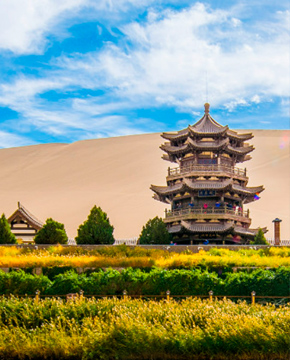
10 Days Silk Road Classic Tour
12 Days Silk Road Tour
8 Days Silk Road Xinjiang Tour from Kashgar to Zhangye
13 Days Silk Road Luxurious Tour from Xi’an to Urumqi
11 Days Silk Road Xinjiang Tour from Kashgar to Zhangye with Duku Highway
11 Days Silk Road Luxurious Tour from Xinjiang to Xi'an
- Xinjiang China Travel
- Why Travel with Us
- North Xinjiang Travel Story
- Travelers' Gallery
- Payment Guide
- Customer Support
- Feedback & Reviews
- Tailor My Trip
Destinations
Call: +86 135 6583 4056 Email: [email protected]
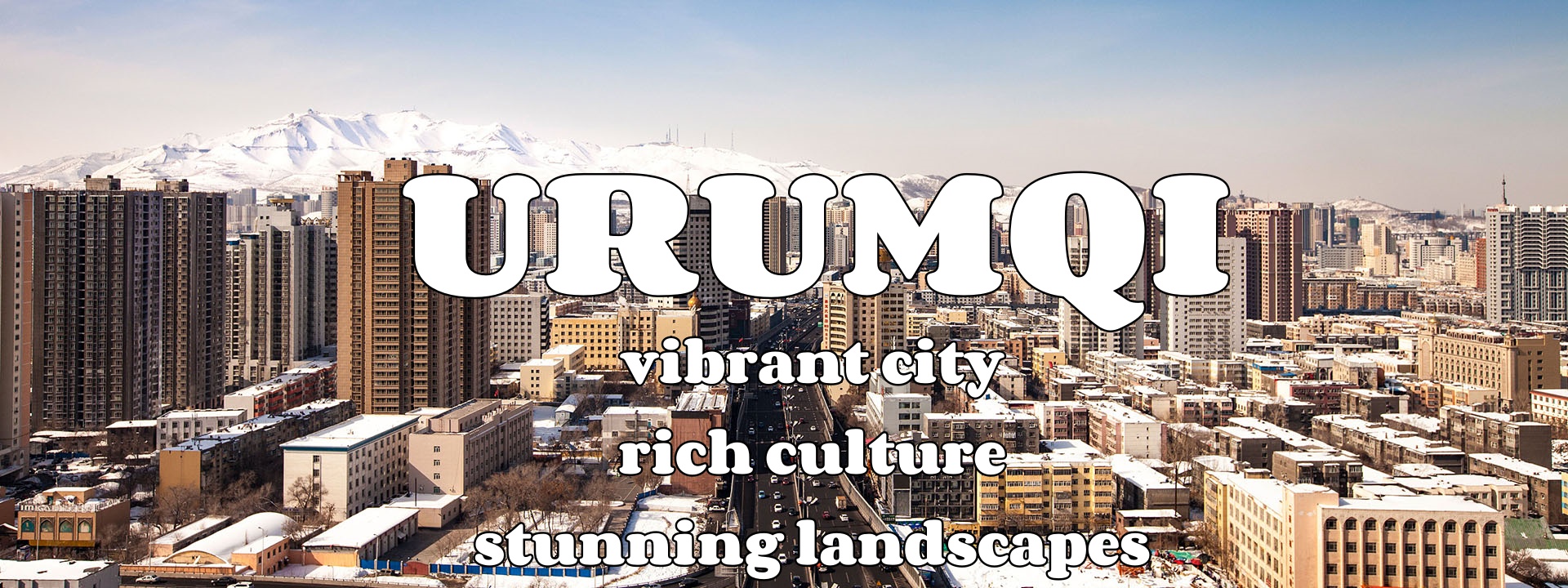
Urumqi Travel Guide
Urumqi introduction.
Urumqi-- the capital of Xinjiang Uyghur Autonomous Region in northwest China. It is a vibrant city known for its diverse culture, bustling markets, and stunning natural scenery. Urumqi is a melting pot of ethnicities and a gateway to the Silk Road, making it a unique and fascinating destination for travelers.
Urumqi is famous for its claim that it is the most inland major city in the world and is the farthest one from any ocean. Geological factors result in an arid continental climate with dramatic temperature changes between days of too-abundant sunshine and night's coldness. Therefore, Xinjiang fruits are juicy and sweet, nicknamed the "Hometown of Fruits."
There are 13 main minorities in Xinjiang. The city's major ethnic groups are Han, Hui, and Uyghur. Culture is so diverse in any other place that each group has its unique cuisine and traditions.
Why Visit Urumqi
Islamic Architecture
In Xinjiang, you can not only experience the local customs but also the style of architecture is also magnificent. Take Grand Bazaar for an example. It is a landmark of Urumqi and a must-visit spot. The Bazaar is in the Erdaoqiao Uighur Residential Area, built by combining Uighur polished grey brick joints with modern stage techniques to produce the atmosphere of retro and Silk Road prosperity.
Beautiful Landscapes
Explore the beautiful natural landscapes surrounding Urumqi, including the Tian Shan Mountains, Heavenly Lake, and the Gobi Desert. The Natural scenery is unique and beautiful, company with the scenery, fresh air, and blue sky are all so perfect.
Fascinating Ethnic Cultures
One of the reasons for visiting the city is to experience diversifying cultures, including exceptional food, music, dance, clothing, various products with ethnic features, customs, yurt, wedding ceremonies, etc. The Uyghurs as the main ethnic groups of Xinjiang, here you can also Experience the unique Uyghur culture, cuisine, and traditions in Urumqi, which is a melting pot of various ethnicities.
Adventure Activities
Engage in outdoor activities like hiking, skiing, and camel riding in the surrounding mountains and deserts. There are several natural ski resorts in the city's suburbs for outdoor enthusiasts and skiing fans. You are filled with amusement as skiing while you enjoy the white scenery dashing through.
Paradise for Food Lovers
Pilaf, shish kebabs, and latiaozi are mouth-watering and blurted out as people mention Xinjiang. However, in Urumqi, smart Uyghur restaurant owners keep developing new dishes such as Naren, Meisitewa, Xiweigu, and Yaerma used to be eaten by Uyghur people in the past time but now for banquets. It is surprising and delightful to see inventions.
Top Urumqi Attractions
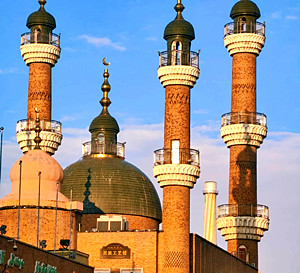
The Xinjiang International Grand Bazaar is a popular tourist destination in Urumqi, Xinjiang, China. It is a vibrant and bustling market that showcases the rich culture and traditions of the region. The bazaar features a wide variety of stalls selling local handicrafts, textiles, spices, and traditional Uyghur food. Visitors can explore the maze-like alleyways, interact with local vendors, and experience the lively atmosphere of the market. The Xinjiang International Grand Bazaar is a great place to shop for souvenirs, sample authentic Uyghur cuisine, and immerse yourself in the unique sights and sounds of Xinjiang's vibrant culture.
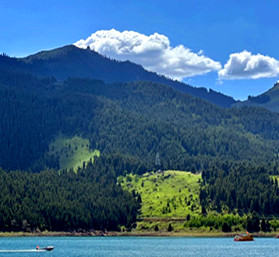
97 kilometers east of Urumqi, located on the hillside of Bogda Peak and with an altitude of 1980 meters, this place is surrounded by snow-capped mountains in the south and dense fir and spruce forests in the west. It's a great location for outdoor activities such as boating on the lake and enjoying the beautiful scenery.
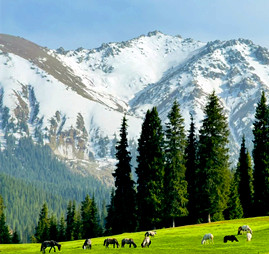
60km around to the city center, covers an area of 120km2, and features exquisite scenery including splendid snow mountain, vast grassland, verdant forest sea, flying waterfall, clear stream, besides that, the colorful meadows with beautiful butterflies flying around and the unique Kazakh ethnic culture add more charm to this land. The cool temperature, fresh air, and lovely scenery all make Nanshan Pasture the closest travel resort to Urumqi.
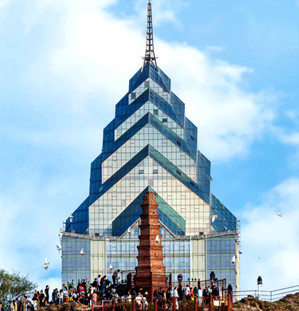
Situated on the east bank of the Urumqi River, the Red Hill gets its name from the ochre sandstone of its body. The mountain has an elevation of 910 meters and is believed to resemble a giant dragonfly from the Heavenly Lake by Bogda Peak. Conversely, the Yamalik Mountain on the west bank of Urumqi River is believed to be the avatar of a demon. According to local beliefs, if these two mountains were to meet, Urumqi would be transformed into a place of vast sea.
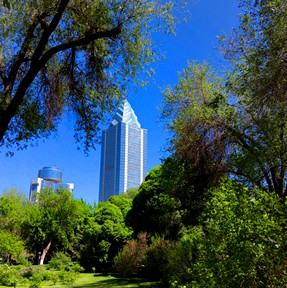
People's Park in Urumqi is a popular urban park located in the heart of the city, offering a peaceful retreat from the hustle and bustle of city life. The park is a favorite spot among locals and tourists alike, providing a serene environment for relaxation, leisure activities, and social gatherings.
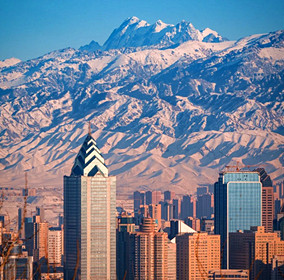
Bogda Peak, also known as Bogda Feng or Bogda Mountain, is the highest peak in the Bogda Shan range of the Tian Shan Mountains, located near Urumqi in Xinjiang, China. The peak stands at an elevation of 5,445 meters (17,864 feet) above sea level and is a popular destination for mountaineers and outdoor enthusiasts.
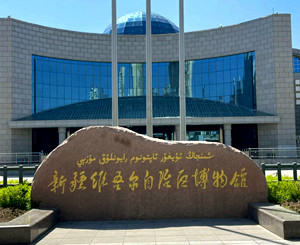
The Xinjiang Museum, located in Urumqi, Xinjiang, China, is a prominent cultural institution that showcases the rich history, culture, and heritage of the Xinjiang region. The museum features a diverse collection of artifacts, exhibits, and displays that highlight the unique blend of cultures and traditions that have shaped Xinjiang over the centuries.
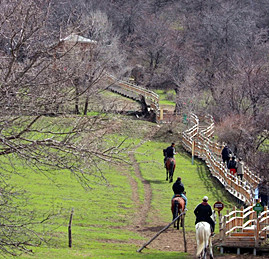
The Modern Glaciers in Daxigou Valley are a fascinating natural wonder located near Urumqi in Xinjiang, China. Daxigou Valley is known for its unique geological formations and stunning landscapes, including modern glaciers that have formed in the area.
Best time to Urumqi
The best time to visit Urumqi is during the late spring and summer months , from May to September .
From May to September in Urumqi, you can expect daytime temperatures ranging from around 15°C to 30°C (59°F to 86°F) . However, evenings can be cooler, dropping to around 10°C (50°F) or lower.
In addition, Urumqi experiences a significant temperature difference between day and night , so It’s best to pack a mix of light, breathable clothing for the daytime and warmer layers for the cooler evenings. Don’t forget sunscreen for protection against the sun, as Urumqi experiences low humidity.
If you're interested in winter sports like skiing, visiting Urumqi during the winter months from December to February can also be a great option.
In this time, the weather is usually cold, with temperatures ranging from around -10°C (14°F) to 0°C (32°F) during the day. Nights can be even colder, dropping to around -20°C (-4°F) or lower. It is important to pack warm winter clothing, such as heavy jackets, hats, gloves, and insulated boots, to stay comfortable in the chilly temperatures. Additionally, be prepared for occasional snowfall during this time.
Transportation in Urumqi
Urumqi is the traffic hub of Central Asia. It is quite convenient for tourists to take flights to arrive in. Urumqi Diwopu International Airport has direct flights to most of the inner cities of China as well .
So far, there are two railway stations in Urumqi. The new one is Urumqi Railway Station , built quite magnificent and modernized, providing express trains to go to inner cities. The other one is named Urumqi Railway South Station .
Urumqi has a well-developed public transportation system that includes buses , taxis , and the BRT (Bus Rapid Transit) system . Buses are a convenient and affordable way to travel within the city and to nearby attractions.
Coach routes from Urumqi almost cover all cities, towns, and villages in Xinjiang . In short, public transportation in Urumqi is getting better and cleaner.
Urumqi also has a metro system with several lines connecting key areas of the city. The metro is a fast and efficient way to travel around Urumqi.
Taxis are readily available in Urumqi and can be hailed on the street or booked through ride-hailing apps. Taxis are a convenient option for getting around the city, especially for shorter distances.
Renting a car is another option for exploring Urumqi and the surrounding areas at your own pace. There are several car rental companies in the city.
Urumqi has a growing network of bike lanes and rental services , making cycling a popular and eco-friendly way to get around the city.
Accommodation
Don't worry about finding a hotel in Urumqi. International chains like Sheraton and Hilton are available there. Even in Heavenly Lake Scenic Spot, you can find accommodations with great service and full facilities for tourists. It's quite exciting that tourists can choose to stay overnight in a Kazakh yurt to experience the ranch life of the locals in Nanshan Pasture. Travelers can also opt to stay in a youth hostel or other chain hotels.
Urumqi Maps you might need
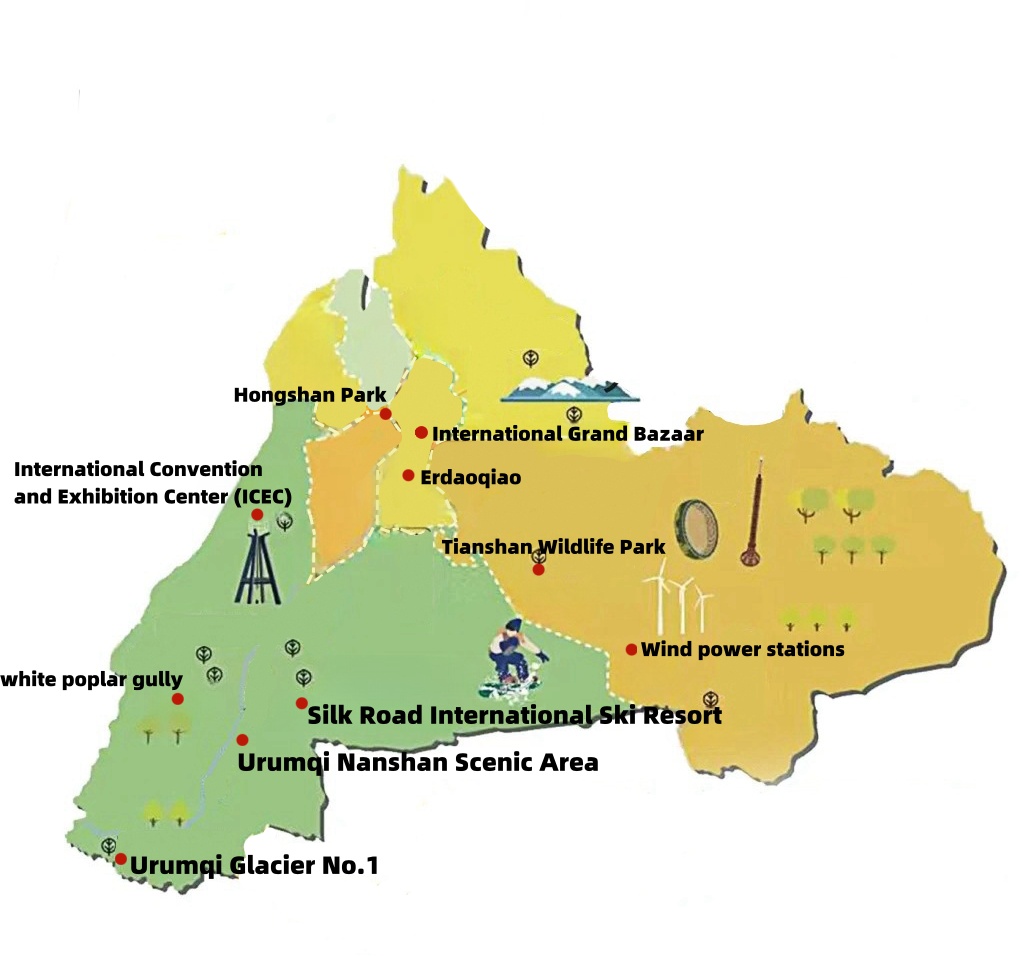
Most Popular Urumqi Tours
18 days grand xinjiang and dunhuang tour.
Kashgar - Taxkorgan - Yarkent - Hotan - Alaer - Kuqa - Korla - Turpan - Urumqi - Fuhai - Hemu - Kanas - Urho - Dunhuang
7 Days Xinjiang Tour From Turpan to Burqin
Urumqi - Turpan - Heavenly Lake - Fuhai - Kanas - Hemu - Burqin
15 Days North Xinjiang and Silk Road Adventure
Urumqi - Fuhai - Hemu - Kanas - Karamay - Turpan - Dunhuang - Jiayuguan - Zhangye - Xining - Xi’an
13 Days Wonderful North Xinjiang Tour
Urumqi - Heavenly Lake - Fuhai - Hemu - Kanas - Burqin - Kuitun - Yining - Tekes - Nalati - Bayinbuluk - Korla - Urumqi
14 Days North Xinjiang Tour to Yili Pastureland
Urumqi - Sayram Lake - Zhaosu - Xiata - Tekes - Kanas - Nalati - Bayinbuluk - Kuqa - Korla - Urumqi
11 Days North Xinjiang Tour from Urumqi to Yining
Urumqi - Heavenly Lake - Wucaiwan - Fuyun - Hemu - Kanas - Burqin - Kuitun - Yining - Nalati - Tekes - Yining
8 Days North Xinjiang: Kanas-Hemu-Turpan
Urumqi - Turpan - Fuhai - Hemu - Kanas - Urho
9 Days Bayinbuluk Grassland, Sayram Lake & Apricot Blossom Adventure
Urumqi - Korla - Bayinbuluk - Nalati - Xinyuan - Yining - Jinghe
11 Days Yili Indepth Adventure & Hiking
Yining - Nalati - Zhaosu - Xianhuatai - Qiongkushitai - Jinghe - Urumqi
11 Days Kashgar & Yining Indepth Tour
Kashgar - Taxkorgan - Yining - Zhaosu - Gongliu - Nalati - Jinghe - Urumqi
9 Days Northern Xinjiang Tour
Urumqi - Fuyun - Keketuohai - Burqin - Hemu - Kanas - Kuitun
9 Days Essence Xinjiang Tour from Urumqi to Keketuohai
Urumqi - Karamay - Burqin - Kanas - Hemu - Fuhai - Keketuohai
Useful Urumqi Travel Info
Urumqi travel tips.
- Urumqi Attraction
- Urumqi Hotel
Urumqi Things to do
- Best Time to Visit Urumqi
- Can't-Miss Food in Urumqi
Start Your Journey
Dignissimos asperiores vitae velit veniam totam fuga molestias accusamus alias autem provident. Odit ab aliquam dolor eius.
- 24/7 Customer Service
- Well-located Hotels
- No Shopping Stops
- No Hidden Charges
- Lowest Price Guarantee
- Expert Guide & Driver
Quick Inquiry
Are you interested in this tour? This tour can be tailored.
Xinjiang Tours
Address: 1903, Unit 1. Building A2 No. 446 Renmin Road, Urumqi,Xinjiang, P.R.C.
- Email: [email protected]
Tel: +86 135 6583 4056
WhatsAPP: +8613565834056
2006 - 2024 © All Right Reserved www.xinjiangtravel.org Design By: TravelCMS

- TEL: +86 135 6583 4056
- +86 28 85223672
- +86 28 85227275
- +86 191 3897 0032

- Beijing Xian Tours
- Shanghai Beijing Tours
- Hong Kong Guilin Tours
- Hangzhou Suzhou Tours
- Kunming Lijiang Tours
- Shanghai Yangtze Cruise Tours
- Chengdu Tibet Tours
- More Short Stay Tours
- China Tours in January
- China Tours in February
- China Tours in March
- China Tours in April
- China Tours in May
- China Tours in June
- China Tours in July
- China Tours in August
- China Tours in September
- China Tours in October
- China Tours in November
- China Tours in December

- High Speed Trains
- China Yangtze Cruise Tour
- Photography
- Desert Adventure
- Ethnic Villages
- Biking Tours
- Kung Fu Tours
- Heritage Sites Exploration
- China Spring Tours
- China Summer Tours
- China Autumn Tours
- China Winter Tours
Notice! 2024 available cruise routes include 4~5 days Chongqing-Yichang(most classic) and 11~12 days Chongqing-Yichang-Shanghai(limited).

- Best-value Yangtze Cruises
- Top Family-friendly Cruise Ships
- Top 3 Luxury Yangtze River Cruises
- Yangtze River Highlights
- Yangtze River Cruise Routes
- Upstream or Downstream?
- Dining & Drinking
- Accommodations
- On-board Activities
- Yangtze Cruise Booking Steps

- Inner Mongolia

- Fanjingshan
- How to Plan Your First China Tour
- How to Plan Beijing Tour
- How to Plan Xian Tour
- How to Plan Shanghai Tour
- How to Plan Guilin Tour
- How to Plan Sichuan Tour
- How to Plan Family Tour
- 2024 China Travel Ideas
- Best Time to Visit China
- What to Pack for Your China Journey
- Make Payment in China
- Updated China Travel News
- Ultimate Chinese Visa Guide
- Chinese Visa Types
- Chinese Visa Requirements
- Do I Need a Visa for China
- Chinese Visa Application
- Chinese Visa Exemptions
- 144-hour Visa Free
- Shenzhen Visa on Arrival
- Hainan 30-day Visa Free
- Embassies & Consulates
- Invitation Letter
- Useful Visa FAQs & Tips
- Entry Regulations
- Baggage Allowance
- Customs Declaration
- Exit Regulation
- How to Book Train Tickets
- How to Collect Train Tickets
- How to Cancel & Alter Train Tickets
- How to Read Train Tickets
- China High Speed Train Types
- Seats Class & How to Choose
- Friendly Facilities on the Train
- The Train Station Departure Process
- Available Food and Drinks on the Train
- Western Toilets on the Train
- Luggage Racks & Baggage Allowance
- Beijing Train Stations
- Shanghai Train Stations
- Guilin Train Stations
- Xian Train Stations
- Chengdu Train Stations
- Hong Kong West Kowloon Railway Station
- Beijing - Xian
- Beijing - Shanghai
- Guangzhou - Shanghai
- Shenzhen - Shanghai
- Chengdu - Xian
- Shanghai - Hangzhou
- Shanghai - Xian
- Chengdu - Chongqing
- Kunming - Lijiang
- Beijing Capital International
- Beijing Daxing International
- Shanghai Pudong International
- Shanghai Hongqiao International
- Guangzhou Baiyun International
- Hangzhou Xiaoshan International
- Chengdu Tianfu International
- Chengdu Shuangliu International
- Xian Xianyang International
- Shanghai - Beijing
- Hong Kong - Shanghai
- Guangzhou - Beijing
- Chengdu - Lhasa
- Shanghai - Guilin
- Shanghai - Sanya
- Travel in Spring Season
- Travel in Summer Season
- Travel in Autumn Season
- Travel in Winter Season
- Weather in January
- Weather in February
- Weather in March
- Weather in April
- Weather in May
- Weather in June
- Weather in July
- Weather in August
- Weather in September
- Weather in October
- Weather in November
- Weather in December
- Top 10 China Destinations
- Top 15 Things to Do
- China World Heritage Sites
- Top 10 Best Natural Beauties
- Top 10 Museums in China
- Top 10 Old Towns & Villages
- Five Great Mountains in China
- Top 10 Monasteries & Temples
- Top 10 Ski Resorts
- Top 10 Beautiful Lakes in China
- 7 Best Beaches in Sanya
- Top 6 Beautiful Waterfalls
- Panda Loving Care
- Having fun on Ice and Snow Festival
- About Us Who We Are Our Team Why Travel with Us Feedback & Reviews Travel Stories Travelers' Gallery Payment Guide Customer Support Contact Us
- Tour Experiences
Destinations
- Travel Guide
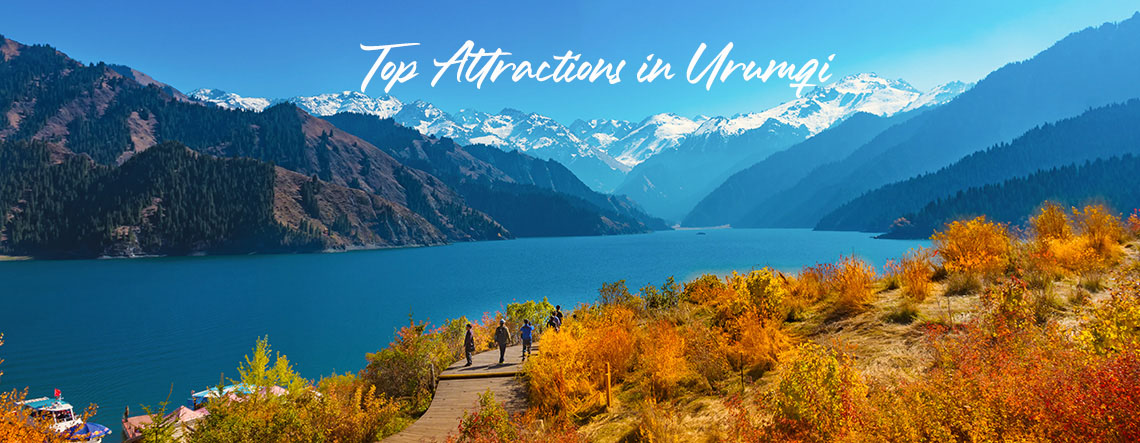
Top 5 Urumqi Attractions | Thing to Do in Urumqi 2024
Urumqi , the capital city located in the northern Xinjiang, is more known as the gateway to Xinjiang and a vital transportation hub to get around Xinjiang . In fact, with rich tourism resources, Urumqi itself serves as an important travel destination too. The city owns more than stunning alpine scenery of snows, grasslands and forests but also multi-ethnic arts, customs and cultures. During your short stay in Urumqi, you can appreciate beautiful Tianchi Lake (Heavenly Lake) of Tianshan Mountains , taste local flavors and feel bazaar culture in Xinjiang International Grand Bazaar , explore mysterious ancient mummies in Xinjiang Regional Museum , take a relaxing hike trip and overlook Urumqi City in Red Hill Park, bask fresh air and summer coolness in Nanshan Pasture . Let’s see what interests you most on Urumqi’s Top Things to Do list below.
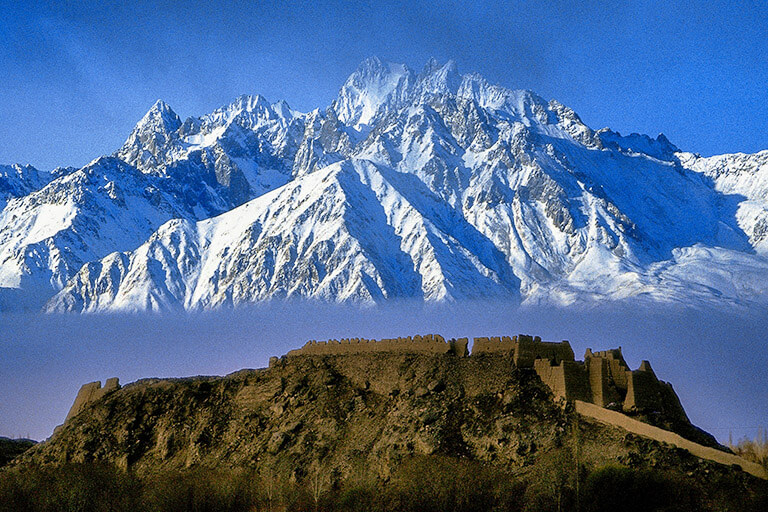
8 Days Classic Xinjiang Tour including Urumqi Turpan Kashgar Tashkurgan
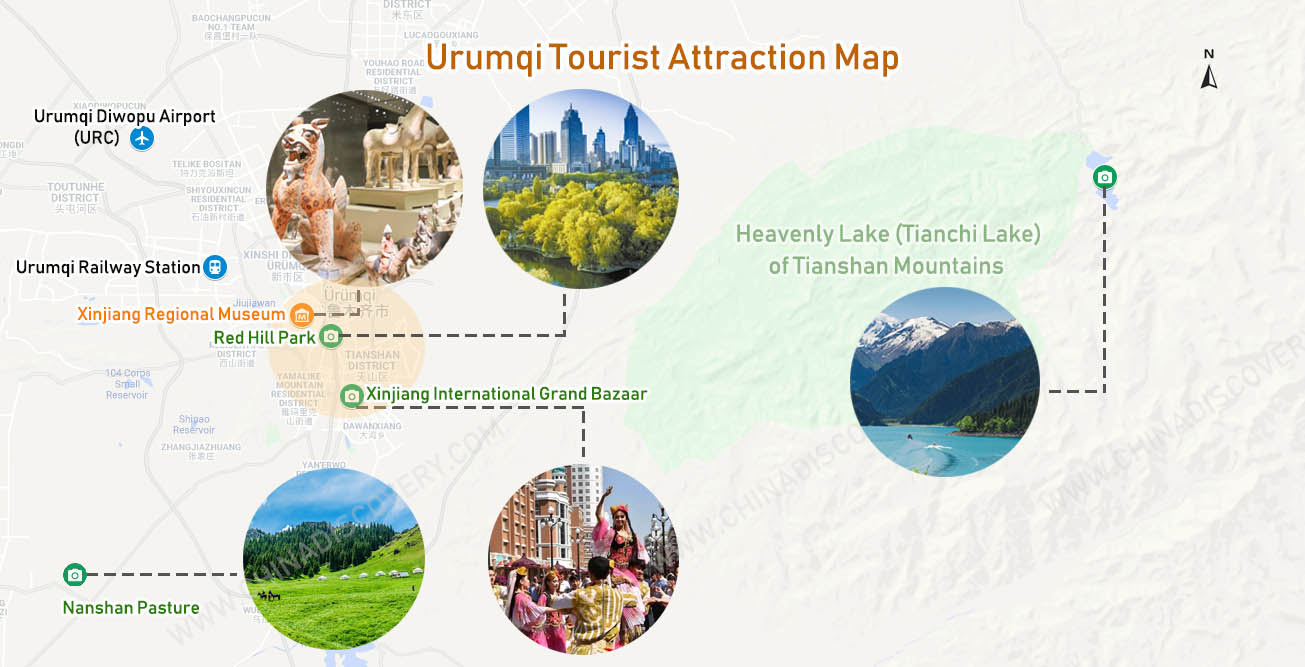
No.1: Tianshan Tianchi - Step into the Fairyland and Explore the Breathtaking Alpine Gem of Tianshan
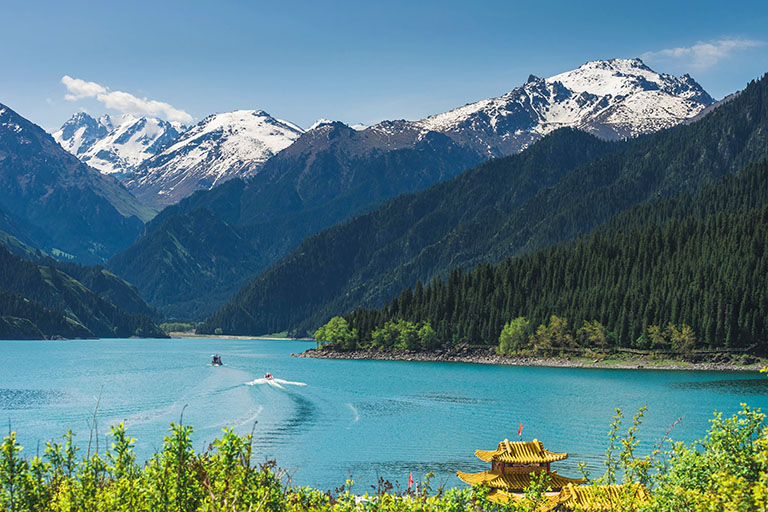
Spectacular Tianchi Lake
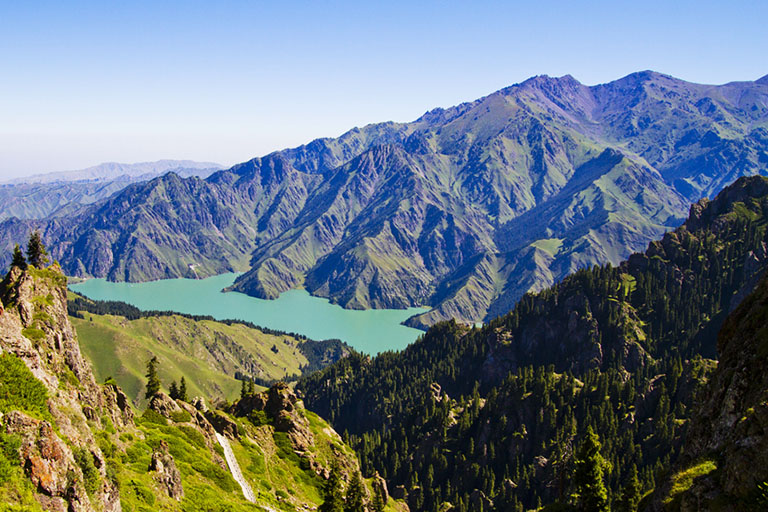
Tianchi Lake Looks Like a Turquoise in Tianshan Mountains
• Ticket : ¥95/person (April~October); ¥45/person (November~March Next Year); shuttle bus: ¥60/person (round-trip) • Opening Hours : 08:30 ~ 20:00 (April~October); 09:30 ~ 19:00 (November~March Next Year) • Recommended Length of Visit : Half a day-one day • Best Time to Visit : May ~ October • Address : Fukang City, Changji Hui Autonomous Prefecture, Xinjiang 新疆维吾尔自治区昌吉回族自治州阜康市
Tianchi Lake or Heavenly Lake of Tianshan Mountains is a huge national AAAAA scenic area which has been listed as a national geopark, a nature reserve and a UNESCO World Natural Heritage site . It is well-known as one of the famous landmarks of Xinjiang and it brags itself with remarkable natural scenery, serenity, geological landform and abundant Chinese myths-related cultural spots.
The center is the Tianchi Lake, a gourd-like blue mountain lake situated on the halfway up the Bogda Peak (5,445 m (17,864 ft).), northern slope of Tianshan Mountains. It is fed by the meltwater of the Tianshan Mountains. The lake was called Jade Pool in ancient times and said to be the looking glass of the Queen Mother of the West. The sparkling and crystal clear blue lake water looks like a giant jade nested in a deep valley. No wonder it gets the title of “the Pearl of Tianshan Mountains”. If the weather is fine, the green lake and reflected surrounding towering snowy peak, dense forests, floating white clouds and the blue sky will take you to a real heavenly lake on the earth.
It takes only 1 hour to drive from Urumqi to Tianchi Lake. From the tourist center (ticket office), a 40-minute shuttle bus will take you up the mountain. Next, you can walk or take a battery chart to the lake. It’s a leisurely experience to walk around the lake and visit spots nearby. Or you can take a sightseeing cruise to the make a loop and visit attractions ashore, or take a thrilling cable car ascending to Mount Maya, overlook the Tianchi Lake and distant peaks, undisturbed forests and meadows, temples, ponds. Summer is the most beautiful season when you can enjoy coolness and amazing green nature sights.
Popular Urumqi Tours with Tianchi Lake:
☛ 3 Days Urumqi Tour including Heavenly Lake and Mummy Visit
☛ 8 Days Urumqi Turpan Kashgar Xinjiang Tour
No.2: Nanshan Pasture - Get Close to the Nature and Enchant Your Eyes and Soul
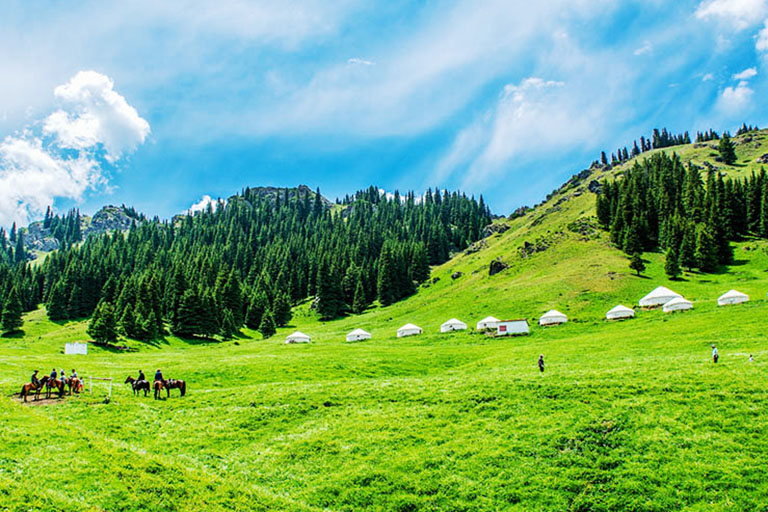
Vast Green Grassland and Kazak Yurts in Nanshan Pasture
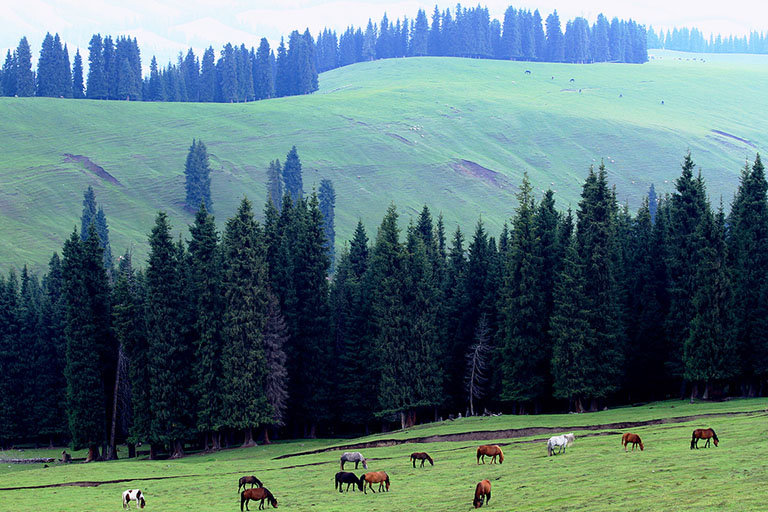
Horses were Grazing in Nanshan Pasture
• Ticket : ¥45 • Opening Hours : 8:00-24:00 • Recommended Length of Visit : Half a day ~ one day • Best Time to Visit : May ~ August • Address : Urumqi County, Urumqi City, Xinjiang 新疆维吾尔自治区乌鲁木齐市乌鲁木齐县
Nanshan Pasture or Southern Pasture refers to the huge mountainous area between the southern outskirt of Urumqi and the north of Kalawucheng Mountain (north range of Tianshan Mountains). It is a wonderful alpine scenic spot, mainly featuring vast green grasslands, primitive forests, favorable climate, alpine pastoral landscape and authentic nomadic folk customs. This pastureland once was a hunting area and rangeland in ancient Tang and Qing Dynasties. Now Nanshan Pasture is a popular summer resort for the locals. If you’re looking for a place in Urumqi to breathe fresh air, enjoy wider space and pure natural scenery, this is it.
Major scenic spots are concentrated in a vertical valley near Urumqi. The most famous and frequently visited one is West Baiyanggou, where you view many tall aspen trees covered the valley, majestic peaks and grotesque rocks with stream flowing through, roaring waterfall and dotted white Kazak yurts. Special Kazak events like horse racing will be hold here. East Baiyanggou has magnificent forests, green meadow, rolling mountains and Kazak nomads. Muxutai is a pasture platform embraced by green hills on three sides. Juhuatai, an alluvial fan with gentle slope, presents great view of boundless prairie, luxuriant woods in elegant waves and herds leisurely grazing. In good weather during summer, you can lie down on the soft lawn, smell refreshing air, savor the comfortable sunshine, rare peace and natural beauty under the blue sky.
Popular Urumqi Tour with Nanshan Pasture:
☛ 4 Days Urumqi Holiday Tour with Southern Pasture Landscape and Kazak Culture Experience
No.3: Xinjiang Regional Museum - View Cultural Relics and Learn about the History and Culture of Xinjiang
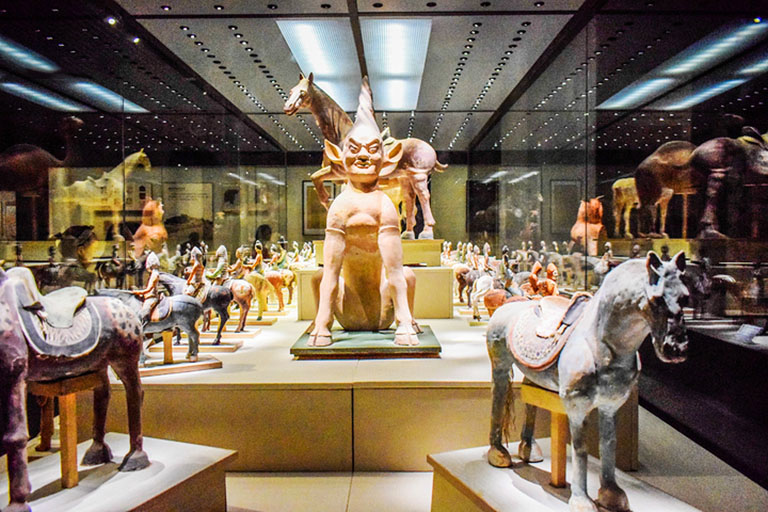
Collections of Ancient Cultural Relics
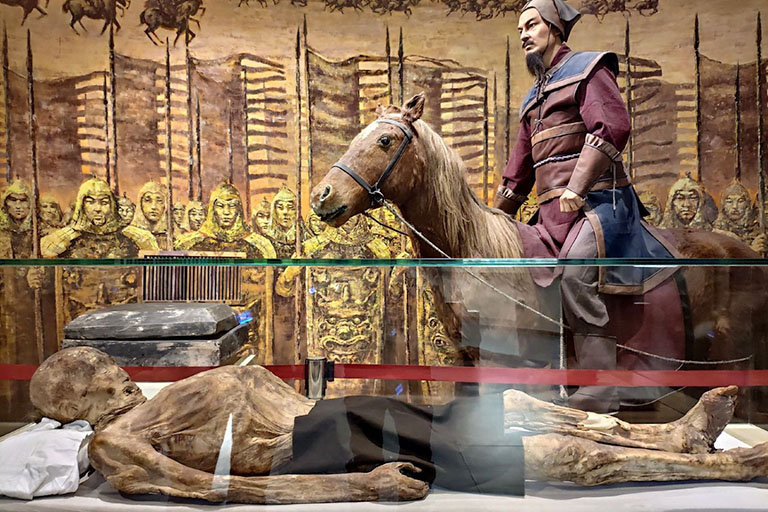
Xinjiang's Ancient Mummy - General Zhang Xiong of Ancient Gaochang Kingdom
• Ticket : Free Admission • Opening Hours : 10:30 ~ 18:00 (close on Monday) • Recommended Length of Visit : 2 ~ 3 hours • Best Time to Visit : All the year round • Address : No.581 Xibei Road, Saybag District, Urumqi, Xinjiang 新疆新疆维吾尔自治区乌鲁木齐市沙依巴克区西北路581号
Xinjiang Museum or Xinjiang Regional Museum is a major attraction in central Urumqi often checked by tourists. With a huge number of collections, the museums focus on showing the long history and splendid cultures of Xinjiang, plus its diverse minority ethnic cultures. Before you officially start your Xinjiang travel, it’s helpful and meaningful to have an informative trip in the museum.
No entry fee is charged. But you can see hundreds of thousands of ancient artifacts of Xinjiang at one go. The Exhibition of the Memory on the History of the Western Regions on first floor displays lots of Xinjiang’s historical and cultural antiques from the Stone Age to the Qing Dynasty. The ancient potteries, jades, bronze, clothes, statues, paintings, coins, golden wares are the best history tellers and proofs of ancient wisdom. In another hall on the first ground, many wax figurines of Xinjiang’s different ethnic peoples, life scenes and items are exhibited to give you a real picture of the local lifestyle. The ancient mummy collection on the second floor is the most famous and impressive part, for six Xinjiang ancient corpses are shown. After visiting, you can know more about the unique funeral culture of ancient Xinjiang. Pluck your courage to closely see the “Loulan Beauty” buried 4,000 years ago.
Popular Urumqi Tours with Xinjiang Regional Museum:
No.4: Xinjiang International Grand Bazaar - Shop Xinjiang Handicrafts and Feel Ethnic Market Culture
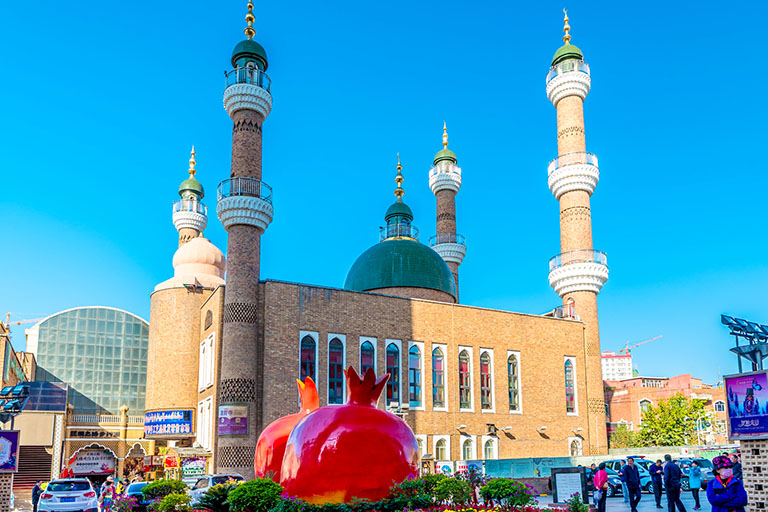
Islamic Architectures in Xinjiang International Grand Bazaar
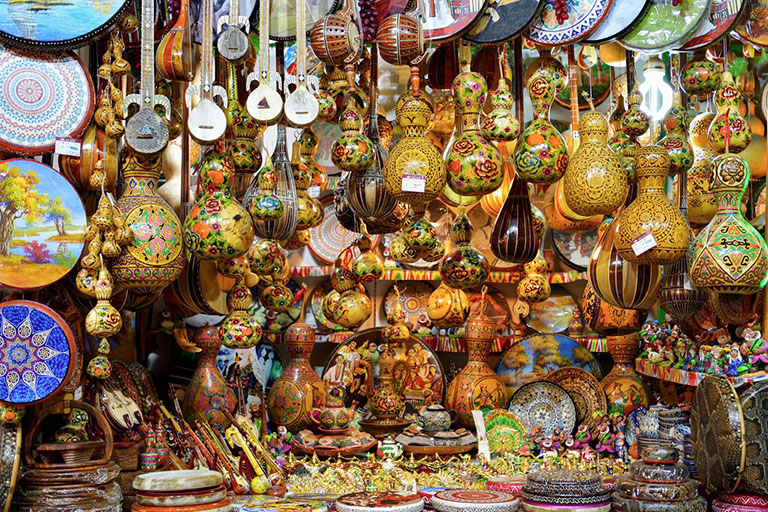
Different Kinds of Xinjiang-featured Handicrafts
• Ticket : Free Admission (¥50 for visiting the Silk Road Sightseeing Tower) • Opening Hours : 10:30 ~ 23:00 • Recommended Length of Visit : 1 ~ 3 hours • Best Time to Visit : All year round • Address : No.8 Jiefang South Road, Tianshan District, Urumqi City, Xinjiang 新疆维吾尔自治区乌鲁木齐市天山区解放南路8号
Bazaar means market in Uygur language, and it is widely distributed throughout Xinjiang, for example in Urumqi, Kashgar, Khotan, etc. Xinjiang International Grand Bazaar , also called Erdaoqiao Bazaar , is the largest bazaar in China which perfectly integrates Islamic culture, architecture, ethnic commerce, entertainment, dining and shopping. It is one of the must-visit landmarks of Urumqi, which is regarded as “the Window of the Xinjiang” and a vivid reproducing of the prosperity of ancient Silk Road.
The bazaar, completed in 2003, covers a floor area of 100,000 square meters. It consists of different zones, including the architectures area, bouquet hall, food plaza with thousands of restaurants, outdoor show square, a mosque and a sightseeing tower. The 80-meter-tall sightseeing tower in the center offers great views of the surrounding buildings from the top. When you and your friends or families stroll around, you can taste lots of local snacks, enjoy the Xinjiang dances and singing, buy some Xinjiang specialty and souvenirs. It’s a good place to appreciate the unique Islamic buildings and experience the special bazaar culture of Uygur people.
Popular Xinjiang Tours with Bazaar Visit:
☛ 10 Days Classic Silk Road Tour (Xian/Dunhuang/Turpan/Kashgar)
No.5: Red Hill Park - Enjoy Leisure in Local Park and Capture A Panoramic View of Urumqi City
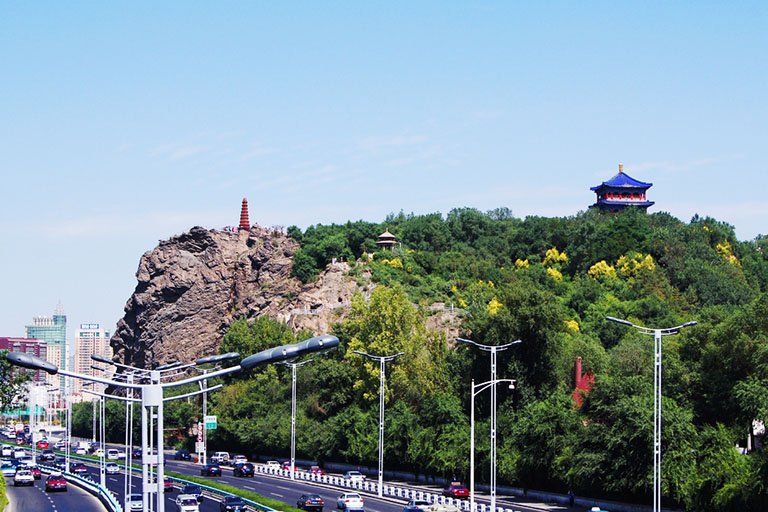
Symbolic Hongshan Pagoda of the Red Hill Park
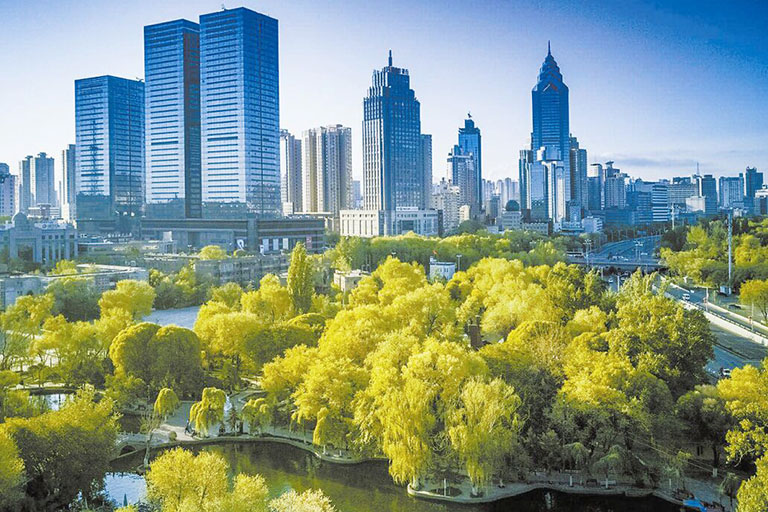
Overlook Urumqi City from the Top of the Red Hill Park
• Ticket : Free Admission • Opening Hours : 10:00~19:00 (May 1 ~ October 14); 10:30~19:00 (October 15 ~ April 30) • Recommended Length of Visit : 1~3 hours • Best Time to Visit : All year round • Address : No.40 Beiyi Alley, Hongshan Road, Shuimogou District, Urumqi, Xinjian 新疆维吾尔自治区乌鲁木齐市水磨沟区红山路北一巷40号
Red Hill Park , or called Hongshan Park in the downtown area is “the Heart of Urumqi” and one of the symbolic attractions in Urumqi. It is a popular local park for recreation and leisure. The park is named after the red-colored hill, which is said to appear over the same period as the Tianshan Mountains rose. Though the hill sits only 910.6 meters above sea level with a low relative height of 60 only, it is regarded as a holy site for its magical legend and fantastic view of the Bogda Peak in the distance.
The park is not very big but has plenty of green plants and entertainment facilities for children and adults. You can take a comfortable walk, relax yourself, enjoy the lovely natural scenery and watch the local daily leisure activities. Climbing up the Yuantiao Pavilion on the highest point of Red Hill, you can get a great panoramic view of the Urumqi city down the hill and the far-away snow-topped Tianshan Mountains. The Urumqi River beneath has gone and be replaced by the modern expressway. The interior of the pavilion exhibits photo gallery of Urumqi city development. Hongshan Pagoda (Red Hill Pagoda) standing on the red rocky bluff is a more than 200-year-old heritage from Qing Dynasty. This delicate tower has gone through ravages of blizzards and earthquakes and remain intact. Colorful night lights make the pagoda even more beautiful. In the park, you can also visit the Dafo Temple, see a statue of Lin Zexu and a giant memorial bronze tripod, have a rest in the lovely pavilions and enjoy a boat trip in the pure Southern Lake.
Popular Urumqi Tours with Red Hill Park:
☛ 5 Days Urumqi Discovery to Turpan and Heavenly Lake
How to Plan A Urumqi Xinjiang Tour
How to Get to Urumqi: Fly to Urumqi from Beijing (4-4.5hrs), Shanghai (5.5hrs), Guangzhou (5hrs), Shenzhen (5.5hrs), Xian (3.5hrs)..., or take a high speed bullet train from Dunhuang (4hrs), Zhangye (7-7.5hrs), Turpan (1hr), etc.
Best Time to Visit Urumqi: May to October when the temperature is comfortable and the seasonal scenery is very beautiful.
Top Places to Visit Urumqi: Tianchi (Heavenly Lake) of Tianshan Mountains, Xinjiang International Grand Bazaar, Xinjiang Regional Museum, Red Hill Park, Nanshan Pasture.
Most travelers start a Xinjiang tour from Urumqi and take Urumqi as the transfer center of visiting the Northern Xinjiang. Usually, tourists spend one day exploring Urumqi’s highlights in the down area, including the Xinjiang International Grand Bazaar, Red Hill Park and Xinjiang Regional Museum. Making a day trip to Tianchi Lake is a popular itinerary if you won’t visit Kanas. Nanshan Pasture is a good summer resort worthy of your visit if you happen to visit Urumqi in summer.
Xinjiang is vast and beautiful. The Northern Xinjiang is most known for the natural beauty while the Southern Xinjiang is characterized rich cultural and historical treasures. Depending on your time and personal interests, you can extend trip to more destinations, such as the Turpan , fairyland Kanas Lake and Hemu Village in Altay, incredibly beautiful Sayram Lake , Wu’erhe Ghost City in Karamay, Ili (Kalajun Grassland, Narati Grassland, Guozigou...) in Northern Xinjiang, and travel further to the Southern Xinjiang’s Kashgar and vicinal Tashkurgan , Taklamakan Desert, Bosten Lake, Tomor Peak, Kuqa, Khotan, etc. You can pick up some highlighting places for a week's travel or haven an in-depth discovery for up to one month.
☛ 8 Days Urumqi Turpan Kashgar Xinjiang Tour ☛ 9 Days Kanas Lake Fairyland Tour from Urumqi
Northwest and Southwest China are two mysterious regions travelers love to visit. Following the ancient Silk Road from Xian to Xinjiang is also a popular travel route. It’s highly suggested that you visit Xinjiang with Dunhuang, Zhangye, Jiayuguan along the ancient Silk Road , or with the holy land of Tibet (Lhasa, Shigatse, Mount Everest, Mount Kailash, Nyingchi...). The nature scenery and distinctive culture will impress you deeply. China Discovery provides not only all-inclusive Xinjiang tours , Silk Road tours , but also can help you customize a wonderful trip on your own.
☛ 10 Days Classic Silk Road Tour from Xian ☛ 11 Days Wild In-depth Silk Road Adventure Tour ☛ 15 Days Classic Ancient China Silk Road Tour with Bullet Train Experience
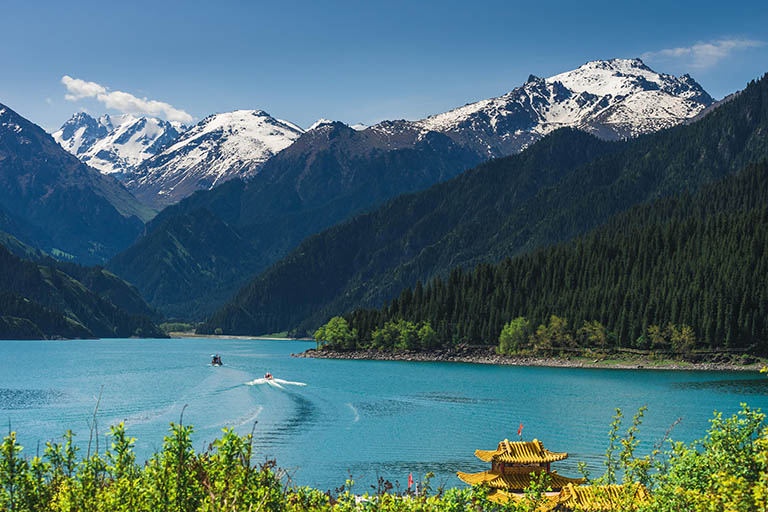
Keep Reading About Urumqi
- Urumqi Tours
- Urumqi Travel Guide
- Urumqi Weather & Seasons
- Urumqi Transportation
- Bullet Trains to Urumqi
- Urumqi Maps
- Urumqi Hotels
- Urumqi Airport and Flights
- Urumqi Railway Station
- Tianchi Lake
- Urumqi to Tianchi Lake
- Nanshan Pasture
- Xinjiang Museum
Keep Reading About Xinjiang Tours & Travel Guide
- Xinjiang Tours
- Kashgar Tours
- Turpan Tours
- Kanas Tours
- Tashkurgan Tours
- How to Plan Xinjiang Trip
- Xinjiang Destinations
- Xinjiang Attractions & Things to Do
- Xinjiang Weather & Seasons
- Xinjiang Transportation
- Xinjiang Maps
- Xinjiang Tips
- Turpan Travel Guide
- Kashgar Travel Guide
- Shache Travel Guide
- Altay Travel Guide
- Hotan Travel Guide
- Kucha Travel Guide
- Ili Travel Guide
- Taklamakan Desert
Recommended Urumqi Tours
Top 3 Urumqi tours chosen by most customers to explore Urumqi in the best way. Check the detailed itinerary, or tailor your own trip now with us.
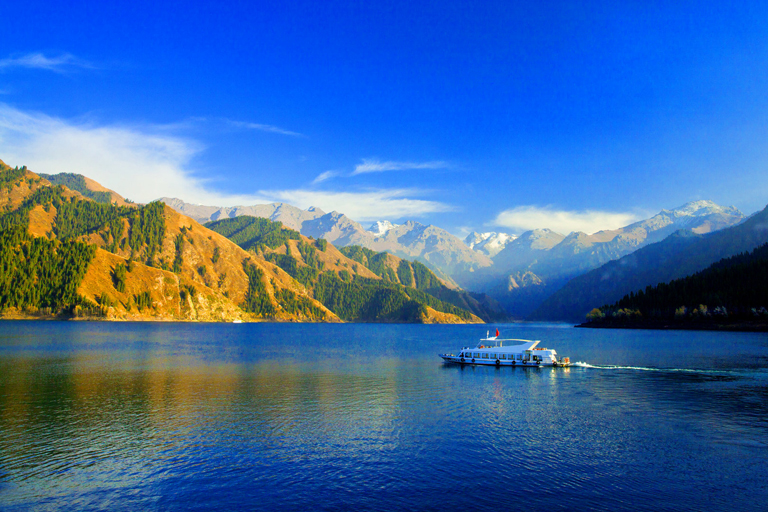
11 Days In-depth Wild Silk Road Adventure Tour (Cultural Relic & Unrivalled Landscape)
Lanzhou / Zhangye / Jiayuguan / Dunhuang / Turpan / Urumqi / Kashgar
Urumqi - Turpan - Kashgar - Tashkurgan
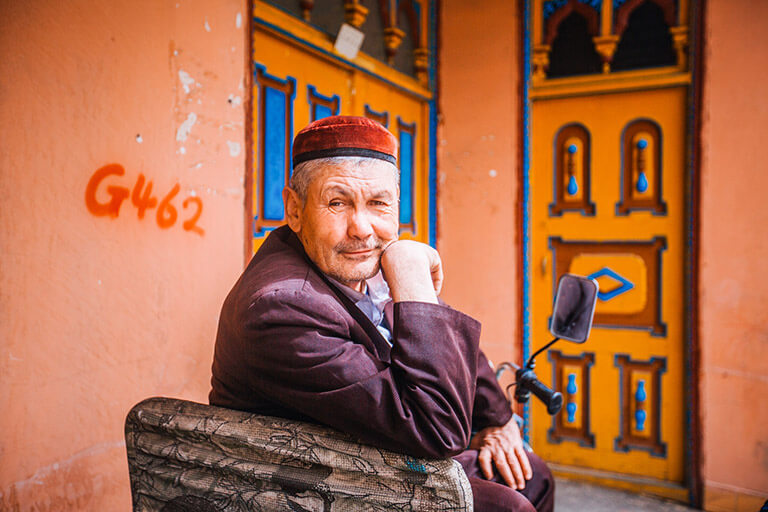
13 Days In-depth Xinjiang Silk Road Adventure Tour
Urumqi / Turpan / Korla / Kuqa / Taklimakan Desert / Minfeng / Hongtan / Kashgar / Tashkurgan
Start planning your tailor-made holiday to China by contacting one of our specialists. Once inquired, you’ll get a response within 0.5~23.5 hours.

Have a question? Get answers from our travel experts or guests
- Your Question:
- Your Email:
- Affordable and valuable price
- 100% tailor-made packages
- Highly rated customers reviews
- Efficient customer support
China Tours
- Top 10 China Tours
- Classic China Tours
- China Tours from Beijing
- China Tours from Shanghai
- China Tours from Hong Kong
- China Tours from Chengdu
- Short China Trips
- Customize China Tour
- China Panda Tours
- Family Tour with Kids
- High-Speed Train Tour
- Silk Road Travel
- Yangtze River Cruise
- Hiking & Trekking Tours
- Photography Tours
- China Minority Travel
- Beijing Shanghai Tours
- Shanghai Yangtze Tours
- Chengdu Jiuzhaigou Tours
- Chengdu Lhasa Tours
- Suzhou Hangzhou Tours
- Guilin & Yangshuo
- Zhangjiajie
“Very good experience”
“WONDERFUL 25 DAYS IN CHINA - PRIVATE TOUR”
“Awesome China tour from northeast to southwest”
Any questions, please email us at: [email protected] or call us at: +86-28-85223672 / +86-28-85227275 / +86-19138970032 (Monday-Friday 9 a.m. to 6 p.m. GMT+8)
- Terms & Condition
- Privacy Policy
- Customer Support
Copyright © 2011-2024. All rights reserved.
Cookie policy
We use cookies to give you the best experience on our website. Continue using our website means you agree with our cookie policy. For more info, please read here .

Urumqi Travel Guide: From Ancient Bazaars to Stunning Mountains
Urumqi is the capital of the Xinjiang Uygur Autonomous Region, located on the northern slope of the Tianshan Mountains and the south edge of the Junggar Basin. As the most inland city that is farthest from any ocean in the world, Urumqi is surrounded by stunning mountains, gorges, lush forests, and wild deserts, being home to multiple natural wonders.
Once an important town along the ancient Silk Road , Urumqi is now the largest city in western China, and also the best gateway to travel to Xinjiang . Since populated by diverse ethnic groups, including Han, Uygur, Kazak, and Hui, Urumqi is where cultural diversity can be discovered in every aspect, including customs, bazaars, cuisine, and various handicrafts.
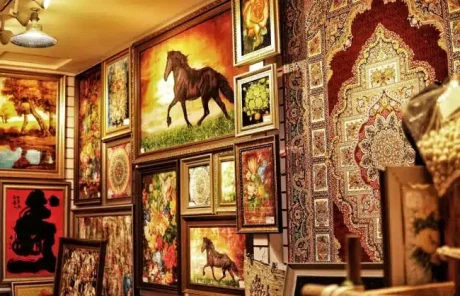
- Chinese Name : 乌鲁木齐 (wū lǔ mù qí)
- Pronunciation : [uːˈruːmki]
- Altitude : About 680-920 meters above sea level.
- Population : 4,085,000 in 2023
Why Visit Urumqi?
- Diverse Ethnic Cultures : The diverse ethnic groups in Urumqi contribute to its diverse ethnic cultures. It will entertain visitors with colorful traditional clothing, tasty Xinjiang food, and a wealth of handicrafts. Xinjiang International Grand Bazaar is the best place to experience its ethnic culture.
- Breathtaking Natural Wonders : Surrounded Urumqi are many natural wonders, including Tianshan Mountain, Heavenly Lake, Nanshan Pasture, etc. Visitors can immerse themselves in the stunning natural beauty and enjoy many exciting outdoor activities.
- Diverse Food : Each ethnic group in Urumqi contributes to its rich and diverse culinary scenery. Here visitors can experience different flavors and food cultures in one go, satisfying their stomachs with aromatic lamb skewers, hand-pulled noodles, pilaf, naan, and more.
- Rich Historical and Cultural Heritage : Xinjiang Silk Road Museum and Xinjiang Regional Museum in Urumqi will offer a glimpse into the region’s history and rich cultural legacy.
Top Attractions & Things to Do in Urumqi
More than a gateway to Xinjiang, Urumqi’s diverse attractions and unique experiences make it a charming destination for any Xinjiang tour. Whether you are seeking cultural diversity or otherworldly natural marvels, look no further than Urumqi.
Urumqi Weather & Best Time to Visit
Urumqi has a temperate continental arid climate. Like most cities in northwest China, Urumqi experiences abundant sunshine, low precipitation, extreme dryness, and large annual and daily temperature variations.
It has four distinct seasons, summers are usually hot and short, winters are long and cold, and spring and autumn are both brief but temperature comfortable. July and August are its hottest months, with the average temperatures hovering around 25-26 °C. January is the time it experiences the lowest temperatures, averaging around -15.2°C.
Generally, the best time to visit Urumqi is from May to October . Though the hot temperatures in summer months, it is the peak season of Urumqi when it offers lush and vibrant grasslands and and most beautiful scenery of the Heavenly Lake and its surrounding areas. September to early October in the early autumn is when Urumqi offers more pleasant weather, stunning autumn scenery, and abundant fresh fruits.
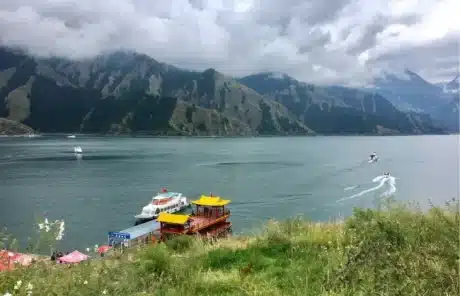
Urumqi Transportation: How to Get to & Travel around
How to get to.
As the gateway to Xinjiang, Urumqi is often the first stop of any Xinjiang tour and can be well-connected through air, train, and long-distance buses.
To fly into Urumqi, you can land at Urumqi Diwopu International Airport. It offers direct flights to/from many domestic cities like Beijing, Shanghai, Chengdu, Xian, Guangzhou, Xining, Lanzhou, Lhasa, etc., and international flights connecting Kuala Lumpur, Alma-Ata, Baku, Dushanbe, etc. Regional flights to Kashgar, Altay, Aksu, Yining, Kanas, etc. are also operated for your convenient transfer to these destinations in Xinjiang . The airport is about 16.8 kilometers from Urumqi’s downtown area, with both shuttle buses and taxis available.
As the last stop of the Lanzhou-Urumqi High-Speed Railway, Urumqi can be easily reached by high-speed trains from most destinations along the Silk Road , like Xian, Lanzhou, Zhangye , Dunhuang, etc. Intercity and regular trains connecting Urumqi and other cities in Xinjiang are also frequent, including trains to/from Kashgar, Turpan, Altay, Hotan, Hami, etc.
How to Travel Around
Traveling around the Urumqi city area and to its major attractions is generally easy thanks to its variety of transportation options. There are regular buses, Bus Rapid Transit, direct lines, etc., and one subway line covering most areas in Urumqi.
Taxis and ride-hailing are convenient and also affordable, for example, a taxi ride from the airport to the city center costs about CNY 30. Attractions in the city center, like Xinjiang International Grand Bazaar, and Xinjiang Regional Museum can be reached on foot.
Recommended Urumqi Tours :
- One Day Urumqi Highlight Tour
- 3 Days Best Urumqi Private Tour
- 4 Days Urumqi Tour with Heavenly Lake and Nanshan Pasture
Tips for Traveling in Urumqi
- Because of the remote western location, Urumqi has a 2-hour time difference from other Chinese cities outside of Xinjiang. Locals typically start their work, breakfast, lunch, and dinner about 2 hours later than other cities.
- Wearing layers or preparing a shirt or jacket is recommended, even on summer days, given the large temperature differences between day and night.
- The UV rays in Urumqi are strong, and sun protection thus is essential. Remember to bring sunscreen, hat, sunglasses, etc.
- Many Urumqi residents adhere to Islamic dietary laws. So be mindful of avoiding pork and pork products.
- Rather than Chinese jin, kilograms are more commonly used to measure goods in Urumqi.
- Urumqi is a city with diverse ethnic groups and unique traditions, keep in mind to respect local customs.
- The nightlife in Urumqi can also be colorful. Besides strolling around the grand bazaar and enjoying local delicacies, visitors can also watch cultural performances, like the Live-Action Musical “The Kunlun Appointment”.
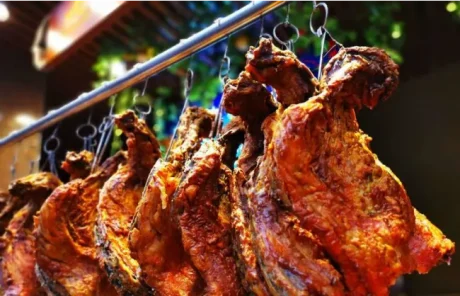
Accommodation in Urumqi: Where to Stay
Urumqi is no short of hotel options, offering a wide range of hotels of different luxury levels from local featured yurts and guesthouses to boutique and luxury hotels.
Staying in the city center is preferred by most tourists, ensuring more hotel and dining options, and convenient access to major attractions. International chain hotels or 4/5-star hotels, like Hilton Urumqi, Shangri-La Hotel Urumqi, and Mirage Hotel, are recommended for foreign tourists for they usually offer more comfortable accommodation experiences, and Western-style breakfasts and are mostly allowed to accept foreigners.
Accommodations near Heavenly Lake and Nanshan Pasture are simple and limited, so it’s recommended to drive back to the city center for an overnight stay after exploration.
Best Silk Road Tours including Urumqi
- 5 Days Xinjiang Highlights Tour with Urumqi and Turpan
- 12 Days Urumqi-Turpan-Korla-Kuqa-Hotan-Kashgar Silk Road Adventure
- 7 Days Silk Road Dunhuang-Turpan-Urumqi-Kashgar Tour
Other Popular Destinations in Xinjiang

Why You’ll Enjoy China Xian Tour

1-on-1 Travel Consultant
Whether you travel with a group tour or tailor-make a private China tour, you’ll receive 1-1 help from a travel expert, who will give you professional advice based on deep and personal knowledge of the destinations.

Expert Local Guides
Get insider access by traveling with a local in each destination. They have firsthand knowledge about local families, where to eat and drink, and the best places for local culture and art. You can trust your guides like friends.


Authentic Travel Experiences
We’ve been creating tens of thousands of China trips for over 20 years. We’ll make your dream China adventure come true by combining China highlights with hidden gems. Beyond just well-known attractions, there will be more.

Flexible Change and Cancellation
You can travel easy with our flexible booking and cancellation policies, in case something unexpected arises or if your China tour itinerary needs to be changed. Your travel consultant is available 24/7 to support your booking.
China Tours
- Top 10 China Tours
- China Group Tours
- China Private Tours
- Visa-free Tours
- Beijing Xian Tours
- Shanghai Xian Tours
- Chengdu Xian Tours
- Yangtze River Cruise
- Tours from Beijing
- Tours from Shanghai
Destinations
- Zhangiiajie
- China Family Tours
- China Food Tour
- China Train Tours
- China Panda Tours
- China Muslim Tours
- Natural Adventure Tours
- China Education Tours
- Great Wall Tours
- Terracotta Warriors Tours
- Silk Road Tours
About China Xian Tour
- Meet the Team
- DMC Partner
- Privacy Policy
- Terms and Conditions
- Travel Blog
We are member of

Username or email *
Send us a quick inquiry
* Tell us your travel requirements/questions here.
I prefer to be contacted via:
Email WeChat WhatsApp Phone call
Your travel consultant will reply within 24 hours.

A TripAdvisor award-winning China travel agency organizing diverse private and mini-group China tours. We offer in-depth experience, free cancellation, flexible & safe trips.
[email protected] [email protected]
WeChat/Whatsapp
86-15129005119
(+86)18792910029 (08:00-21:00 Beijing Time)
Accept & Continue
Discovering the Hidden Gems of Urumqi: A Travel Guide
Urumqi, the capital of the Xinjiang Uygur Autonomous Region in China, is a city that offers a unique blend of history, culture, and natural beauty. With its diverse population and fascinating history, Urumqi is a destination that is often overlooked by travelers visiting China, but is well worth a visit. In this guide, we’ll take a closer look at what the city has to offer and give you some tips on how to make the most out of your visit.
One of the must-see destinations in Urumqi is the Xinjiang Regional Museum, which is a great place to learn about the history and culture of the Xinjiang Uygur Autonomous Region. The museum has a wide range of exhibits, including artifacts from the region’s various ethnic groups, such as the Uygur, Kazakh, and Hui, as well as a collection of ancient mummies that were discovered in the region.

Another popular destination in Urumqi is the Hong Shan Park, which offers a great opportunity to escape the city and experience the natural beauty of the surrounding area. The park is a great place for hiking, with several trails that offer scenic views of the city and the surrounding mountains. Visitors can also see the ancient tombs that were discovered in the park, which are believed to date back to the Han Dynasty.
For those looking to experience the culture of the Xinjiang Uygur Autonomous Region, Urumqi is home to several ethnic minority villages, such as the Uygur village of Tiemenguan, which is located on the outskirts of the city. Visitors can see traditional Uygur houses, take a traditional Uygur dance performance and taste local Uygur food.
Urumqi is also known for its food, which is a unique blend of Chinese, Uygur, Kazakh and other ethnic flavors. Visitors can try traditional Uygur dishes, such as the hand-pulled noodles, laghman and Uygur-style BBQ, as well as Chinese and Kazakh dishes. The night markets and street food in Urumqi offer a great opportunity to try a wide variety of local dishes.
In conclusion, Urumqi is a city that offers a unique blend of history, culture, and natural beauty. With its diverse population and fascinating history, Urumqi is a destination that is often overlooked by travelers visiting China, but is well worth a visit. The city offers a wide range of activities, from visiting museums and parks to experiencing the culture of the Xinjiang Uygur Autonomous Region and trying the local food.
It is important to note that the Xinjiang Uygur Autonomous Region is a complex issue and the political situation in the region is sensitive. Please check the latest regulations and travel restrictions before planning your trip and also, keep yourself updated with the latest situation of the country you are visiting.
Leave a Comment Cancel Reply
Your email address will not be published. Required fields are marked *
Save my name, email, and website in this browser for the next time I comment.
- Xinjiang Tours
- Attractions
- Top 10 Things to Do
- Transportation
- Travel Tips
Urumqi Attractions
One of the landmarks of the city is Red Hill with its emerald greenery, pagoda, and shrines. The hill rocks are reddish-brown, hence the name Red Hill. Historical sites on the hill once included the Ebo (stone cairn used by tribesmen to worship and sacrifice to their gods) built by the nomadic Oyrat Tribe; and the Temple of the Jade Emperor and the Temple of the Great Buddha built in the Qing Dynasty (1644 - 1911). These splendid temples attracted swarms of visitors and made the hill a holy place where worshipers chanted Buddhist sutras and conducted religious ceremonies. Unfortunately, almost all the buildings were destroyed during the war, leaving only the pagoda at the top. Today, local people regard the hill as the symbol of the city. People's Park, also called 'the park for sharing happiness', is on the west bank of the Urumqi River. It was originally a stretch of marshland and lakes surrounded by luxuriant centuries-old trees. Now it is a scenic, tree-shaded park with pavilions and a lake where you can hire a rowboat. The best time to visit is in the morning when local people exercise.
Xinjiang Regional Museum located in the downtown area since 1953, displays archaeological treasures and local relics from the Silk Road. Cultural relics excavated on the ancient Silk Road include silk, pottery, porcelain, terra-cotta figures, weapons, scriptures, even some mummies discovered in the vast desert. In addition, articles from various ethnic groups are shown. These include clothing, household utensils, handicrafts, hunting tools, and musical instruments, as well as a Uygur house and various yurts. The most famous landscape gem near Urumqi is Heavenly Lake (also named Tianchi Lake), particularly refreshing to visitors arriving in the city from the barren Xinjiang deserts or from China's granite cities. A moraine lake hemmed in by majestic snow-crowned peaks west of Bogda Mountain, Tianchi is 3,400 meters (11,125 feet) long, 1,500 meters (4920 feet) wide, 1,980 meters (6494 feet) above sea level. The pristine scene is stunning. A one-day tour usually consists of a boat ride on the lake, or a ride or walk along the lakeshore. Southern Pasture is an area at the northern foot of Karawuquntag Mountain 75 kilometers (46 miles) south of Urumqi. One of the most spectacular spots here is the West White Poplar Gully. Traveling through this narrow verdant gully is a unique experience for sightseers who love snowcapped peaks, waterfalls, dragon-spruce trees and wild flowers. An ideal place for an excursion, visitors can take a horseback adventure guided by local Kazakhs.
- 1 Understand
- 3.1 By plane
- 3.2 By train
- 4.1 On foot
- 4.2 By metro
- 4.3 By taxi
- 5.1 Nan Shan (南山)
- 7.2 Mid-range
- 7.3 Splurge
- 9.2 Mid-range
- 9.3 Splurge
- 10 Stay safe
- 12.1 Consulates
<a href=\"https://tools.wmflabs.org/wikivoyage/w/poi2gpx.php?print=gpx&lang=en&name=Urumqi\" title=\"Download GPX file for this article\" data-parsoid=\"{}\"><img alt=\"Download GPX file for this article\" resource=\"./File:GPX_Document_rev3-20x20.png\" src=\"//upload.wikimedia.org/wikipedia/commons/f/f7/GPX_Document_rev3-20x20.png\" decoding=\"async\" data-file-width=\"20\" data-file-height=\"20\" data-file-type=\"bitmap\" height=\"20\" width=\"20\" class=\"mw-file-element\" data-parsoid='{\"a\":{\"resource\":\"./File:GPX_Document_rev3-20x20.png\",\"height\":\"20\",\"width\":\"20\"},\"sa\":{\"resource\":\"File:GPX Document rev3-20x20.png\"}}'/></a></span>"}'/>

Urumqi (Pronounced: ÜH-RÜM-chee ) (Chinese: 乌鲁木齐 Wūlǔmùqí ; Uyghur: ئۈرۈمچی) is the capital of the Xinjiang Uighur Autonomous Region , administered by the People's Republic of China . The city has a population of around 2.5 million and is in the Tian Shan mountains.
The name Ürümqi comes from Mongolian , meaning "great", a short form of the full Mongolian name meaning "great pasture", as the Mongols were the last major power to control the area prior to the Qing conquest. Following the Qing conquest, the city was named "Dihua" (迪化 lit. "to enlighten and civilize") by Emperor Qianlong, a name which stuck even through the Republic of China era. Following the communist revolution, the new People's Republic of China government changed the name back to Ürümqi in 1954, as "Dihua" was deemed too condescending to the ethnic minorities in the region.
Urumqi is famous for its claim that it is the most inland major city in the world, that being the farthest from any ocean; 2,300 km or further.
There are two major ethnic groups, a quarter million of the original Uyghur inhabitants of the area and 1.5 million Han (ethnic Chinese); the city has a higher proportion of Han than elsewhere in the region. Other ethnic groups in Urumqi include Kazakhs, Kyrgyz, Mongols and Hui Muslims.
Despite what some of the guidebooks say, Urumqi has a lot to offer and can provide a great introduction to Xinjiang.
Regardless of ethnicity, most people in Urumqi can speak some level of Mandarin . However, in some parts of the city Uyghur , a Turkic language, is dominant. Few people speak English, even in some of the large hotels. When taking a taxi, it is a good idea to have a piece of paper with the name of your destination written in Chinese. Most government signs are bilingual in Uyghur and Chinese, as are signs and menus in Uyghur-owned shops and restaurants.
All long-distance trains use the Main Railway Station , 20 km northwest of the city. This includes the fast trains to Lanzhou (12 hours), Xian (plus 3 hours), Beijing (plus 9 hours) and Wuhan (plus 8 hours), and international trains to Kazakhstan via Khorgos (24 hrs) or Dostyk (30 hrs).
- 43.874 87.419 2 Wulumuqi Main Railway Station ( Wūlǔmùqí Huǒchēzhàn ). Huge modern concourse with shops, toilets and plenty of seating. Foreigners are searched and scanned on arrival. The ticket hall is upstairs. A taxi to or from downtown will cost ¥25-30 and take 20 min; the queue for taxis may exceed an hour. ( updated Sep 2018 )
The Northern Long-Distance Bus Station is at Heilongjiang Road. Almaty in Kazakhstan (via Khorgos) takes about 24 hours and costs ¥440. Tickets can be bought at Bianjiang Hotel, room 2121 (边疆宾馆2121号房间) or at the international bus station at Nianzigou (碾子沟国际客运站). The business of clearing immigration & customs at Khorgos makes the travel time variable. To Khorgos itself is 14 hours; other destinations are Burqin (13 hr), Tacheng (12 hr), Yining (or "Yili") (13 hr). Lanzhou is a weary 40 hours, take the train.
The Southern Long-Distance Bus Station (南郊客运站) is in the southern part of city, across from Shuishang Amusement Park (水上乐园). Destinations include Turpan (3 hours), Korla (10 hours), Kuche (17 hours), Hotan (24 hours), and Kashgar (24 hours).
China Highway 312 is a motorway crossing Xinjiang from Gansu to the border with Kazakhstan. Most destinations within Xinjiang can be accessed via private car. Drivers tend to congregate near the bus stations and will often approach passengers shouting their destination. Drivers usually try to fill the car with four passengers, but you can also rent the whole car (包车; bāochē). In almost every case, a car will save hours of travel time over a bus.

The city center is big, and separated into different 'centers'. You can walk, but distances are large, roads are wide, and ongoing building work will block your path. Furthermore, in summer it gets very hot and in winter it can drop to -35°C (-31°F) at night.
The northern section (from the international airport to Balou) of the first line of the Urumqi Metro has just been opened. You must show ID to ride. All signs and announcements are trilingual in Chinese, Uyghur and English.
Metered taxi fares start at ¥10 for the first 3 km. There are also black taxis (illegal), driven nowadays by anyone, male or female. Fares for these are negotiable and they are very handy during rush hour when metered taxis are tough to come by. A ride within the city should not exceed ¥20, but the airport and main railway station will be more.
Bus number 52 goes from the round about near the airport to the museum. Other useful routes running generally north–south are 101, 61 and 63.
The very visible BRT (Bus Rapid Transit) Buses are a quick, efficient and very crowded way from getting from one end of the city center to another. BRT1 and 2 are very useful. BRT1 runs straight down Youhau Lu to the train station. BRT 3 connects the grand bazar, People's Theater and Square and ultimately terminates with a connection to BRT1 at its northern end. Just put ¥1 in the box on the way onto the platforms and then squeeze onto a bus. These are run along a segregated busway - something of a cross between a bus and a tram.

- 43.674859 87.33251 1 Geographical midpoint of Asia monument ( 亚洲大陆地理中心 ).
- Shuimogou Park ( 水磨沟公园 ), 472 Shuimogou Road, Shuimogou District (磨沟区水磨沟路472号) ( Bus routes 8 and 801 ), ☏ +86 991 4684055 , [email protected] . 07:30-21:30 . Free . ( updated May 2018 )
- Confucian Temple , Qianjin Lu. . A beautiful, quiet and peaceful temple. To find it follow the red wall alongside the Autonomous Regional Party Committee building north from People's Square. Take the first turn to the right and follow the road east to the end where you will find the temple. It closes at 13:00 for lunch.
- Liyushan Park , No.158 Kunming Rd . The park is showing old trees from the desert, large stone trees, stones with carvings from BC and some Przewalski horses (which are rare) plus other animals. The north entrance is hard to find and just behind the Yema International Business Hotel (4th floor of the building in the back yard). Admission is free .
Navigation menu

Urumqi Travel Tips
Climate and Weather The temperature in Urumqi fluctuates greatly between day and night. Urumqi is extremely dry due to its geographical location and continental climate. Spring and autumn are short while winter and summer are long. Remote as it is, the local inhabitants fondly call it 'Urumqi' which translates to mean graceful pasture. Spring in Urumqi comes comparatively late. Usually the northern suburb of Urumqi has the first touch of spring in late March, the downtown area some two weeks later and the southern suburb ten days later again. Urumqi in summer is flowery and lush. Summer lasts typically for about 90 days in the northern suburb and about 60 days in the downtown area. Urumqi is an ideal place for a summer holiday when the average downtown temperature is about 23 C (about 73.4 F). From late August, autumn comes to Urumqi, a golden season of fruit harvests. In October you will experience fluctuations between day and night temperatures. The temperature of the long winter in Urumqi is around -15 C (about 5 F), but the scenery makes up for the cold at that time. The best period for visiting Urumqi is from May to October when flowers are in full bloom and the melons and fruits smell sweet and are ripe for the picking. Dress warmly even when traveling in the hottest month (July and August) for the temperature differences between morning and night. Be sure to bring a sweater and trench coat in May, June, September and October. During the cold winter (November to March), you will need heavy winter wear. Local Festivals and Folk Custom The most important local festivals are the annual Corban Festival and Lesser Bairam. According to the Islamic calendar Corban Festival falls on December 10th and Lesser Bairam is 70 days before of Corban Festival. Having a strong ethnic flavor, Guniang Zhui (a kind of funny way to express love between young men and women) and Diaoyang (a traditional sport of the local minority) are very interesting tourist activities at that time. If you are lucky enough, you can appreciate such amusing movements. Corban Festival is one of the most important festivals. It is also known as 'Sacrifice Festival', which is hosted every December 10th by Islamic population. In preparation all Muslims should clean and dress up to attend the ceremony at the Great Mosque. During the three-day holidays, people go door to door to exchange greetings in their best ethnic costumes. All homes serve the visitors delicious mutton. The thumping singing and dancing parties will be held in both urban and rural areas. Some sports activities: such as horse races, wrestling and sheep snatching are most popular among the Kazaks, Ozbeks and Tajiks nationalities. Lesser Bairam is also called 'Fast breaking Festival'. It is the New Year festival of the Hui nationality as well as other groups. Every adult Muslim fasts one month every year. During the Ramadan, the Muslims eat either before sunrise or after sunset. The last day of Ramadan is a holiday. The annual Silk Road Snow Folk Festival (Sichou Zhilu Bingxue Fengqing Jie) is a rising tourist festival in Urumqi. The grand opening ceremony is held in December and the festival usually lasts till the following March offering tourists a different travel experience. Other Odds and Ends Phone Dialing Code: 0991 Postcode: 830000 Emergency Numbers: Fire: 119 Traffic: 122 Ambulance: 120 Police: 110 Weather Forecast: 121 Consumers' Complaint: 12315 Useful Numbers First Aid Center of Urumqi: 2833000 Zip code inquiring: 184 Phone number inquiring: 114 Tourist complaint: 2831902 Toilet Facilities: Using toilets in the downtown area of Urumqi costs about 0.2 Yuan. Post Office: Yangzijiang road Branch (city center): 4, Yangzijiang road Jie Fang Bei road Branch (city center): 61, Jiefang Bei road Beijing road Branch (south suburb): 5, Henan Xi road Money Urumqi Branch of Bank of China offers currency exchange service. Address: 343, Jiefang Nan Lu. Hospital: Urumqi No. 1 People's Hospital Address: 91, Jiankang Lu Urumqi Shi You Yi Hospital Address: 22, Shengli Lu Famous University: Xinjiang University: 14, Shengli Lu Important Taboo and Other Notes: 1. Do not shake water off your wet hands in public. 2. Do not irritate Muslims by eating pork and by speaking about pigs in their presence. 3. Respect the customs and habits of ethnic minorities. 4. Protect yourselves against the elements in all seasons. Be careful about your drinking water. Boil it first. 5. You will come upon spectacular scenery; so do bring your photographic equipment along. 6. Avoid drinking hot tea after eating fruits to avoid diarrhea. 7. Though the 'clock time' in Xinjiang is just the same as the rest of China, in fact there is a two-hour difference in longitude between Urumqi and Beijing. For this reason the daily working hours are: 10:00 - 14:00, 15:30 - 19:30 While in Urumqi, you should modify you rest and dining times to be two hours later than if you were in a city in Middle China, otherwise you might feel out of step with local life. But don't forget that bus, train and flights all adopt Beijing Time. If you booked a flight to arrive or depart Urumqi at around 08:00, then you may find it is quite dark at that time. Please keep this in mind when making reservations.
China Tours You May Like
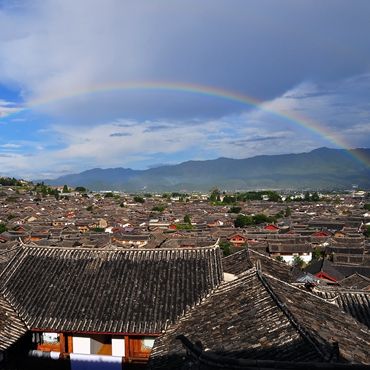
China Ancient Town Exploration Tour, from US$2017
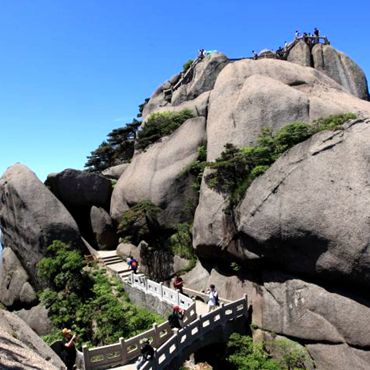
Beautiful Landscape and Others
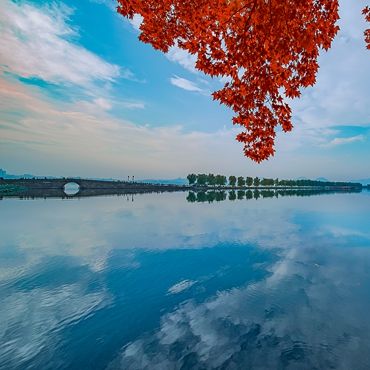
China Fairyland Photography Tour, from US$3453
Want a tailor-made urumqi tour or china tour, select your desired option below to share a direct link to this page, enquire now.
- First Name *
- Last Name *
- Phone/WhatsApp
For the ultimate China tour experience
- Zhangjiajie
- Three Gorges
- Yan'an
- Qiandongnan
- Xishuangbanna
- < 5 Days
- Family Tours
- Photography Tours
- Gourmet Tours
- Home Stay Tours
- Landscape Tours
- Minority Exploration Tours
- Kungfu Tours
- Ancient Town Tours
- Farming Participation Tours
- Honeymoon Tours
- Bridal Art Tours
- Accessible Tours
- Hiking Tours
- Architectural Culture Tours
- Biking Tours
- Adventure Tours
- Other Packages
- The Classic “Top 4” plus the Yangtze Cruise
- The Jade Triangle Tour to Beijing, Xi’an and Shanghai
- The Golden Triangle Tour to Beijing, Guilin and Shanghai
- The Classic "Top 4" to Beijing,Xi'an,Guilin and Shanghai
- China Family Tours
- Guilin Tours
- Beijing Tours
- China Guide
- Where Are We
- Business Certificate
- Honors We’ve Got
- Membership & Partnership
- Why Choose Us
- Terms & Conditions
- Privacy Statement
- Booking & Cancellation
- Payment Guide
- Tailor Tours

Far West China

Urumqi – Capital of Xinjiang, China
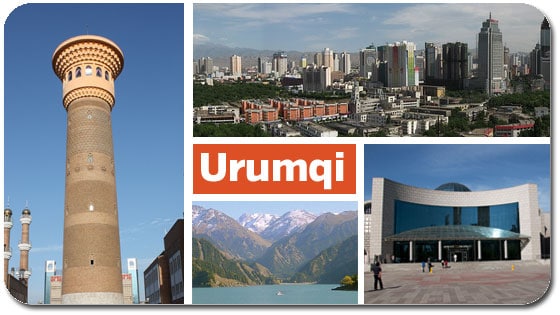
Urumqi At a Glance
- Chinese Name: 乌鲁木齐 (wūlǔmùqí)
- Uyghur Name: ئۈرۈمچى
- Population: Over 3,000,000
- Transportation: The Diwupu International Airport and the Urumqi Train Station . The new train station is also open.
- Trivia: Bill Gates spent a few hours of his honeymoon here looking at the mummies that are still on display at the local museum.
Where is Urumqi?
Historically known as Dihua or Tihwa , the name “Urumqi” is actually a Mongolian word that means “beautiful pasture”. Those beautiful pastures have now been replaced by a sprawling metropolis and a hub of trade between China and Central Asia.
Urumqi is a city that is geographically located in a valley among the TianShan, the mountain range that essentially cuts Xinjiang in half. Over the past couple decades it has become a crowded city which is thankfully not a far drive from beautiful nature like the Heavenly Lake or the Southern Grasslands.
If you’re planning to visit the province of Xinjiang, chances are that you’re going to have to spend some time in the capital of Urumqi. Most every flight into the Xinjiang province at least makes a stop in Urumqi and most of the tour groups make this their starting point.
Most people are either scared of the unfamiliar surroundings or unaware of what the city has to offer so they disregard Urumqi, China as a place to pass through, not enjoy. The good news is that there is plenty to see and do in and around Urumqi.
It’s also a great place to shop for those last-minute souvenirs and the variety of food is incredible. Best of all, Urumqi is home to the Xinjiang Autonomous Region Museum, a must-see prior to any other travel throughout the province.
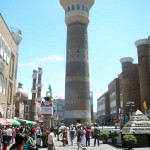
Urumqi China Travel Info
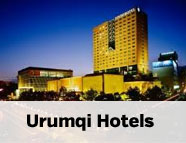
Urumqi Hotels at a Glance:
– Urumqi Sheraton : a 5-star option – Luxemon Yindu : a 5-star option – Lucky Chance : a comfortable 3-star
Urumqi Hostels at a Glance:
– MaiTian Hostel : my recommendation – White Birch Hostel : popular but far
*Remember!* Grab the updated FarWestChina Xinjiang travel guide to help you plan your travels!
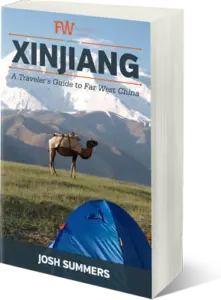
Popular Urumqi China Tourist Destinations

Urumqi International Bazaar
Shop, eat and take pictures.
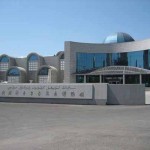
Xinjiang Autonomous Region Museum
Home of the famous mummies!
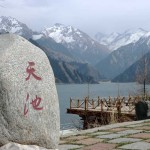
Xinjiang’s Heavenly Lake
Urumqi’s most beautiful natural scenery.
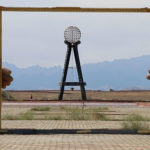
Geographic Center of Asia
The most inland point of Asia is near Urumqi.
Transportation to/from Urumqi, China
Flying to/from urumqi, china.

Urumqi is a busy airport which flies to every airport in Xinjiang as well as this small sample of other cities:
- Urumqi to Beijing (direct daily)
- Urumqi to Shanghai (direct daily)
- Urumqi to Chengdu (direct daily)
- Urumqi to Xi’an (direct daily)
- Urumqi to Guangzhou (direct daily)
- Urumqi to Taiwan (6 days/wk)
- Urumqi to Moscow (4 days/wk)
- Urumqi to Islamabad (3 days/wk)
- Urumqi to Almaty (direct daily)
Taking the Train to Urumqi

For most people, the train is the most common form of transportation outside Xinjiang. There are multiple trains that leave the station per day heading everywhere within the province and as far as Shanghai and Beijing.
In November 2014, Xinjiang opened its first high speed train that runs from Urumqi to Lanzhou. Eventually, it will connect Urumqi with Beijing in 2017. Use the search box below to determine schedules and purchase tickets:
Map of Urumqi, Xinjiang
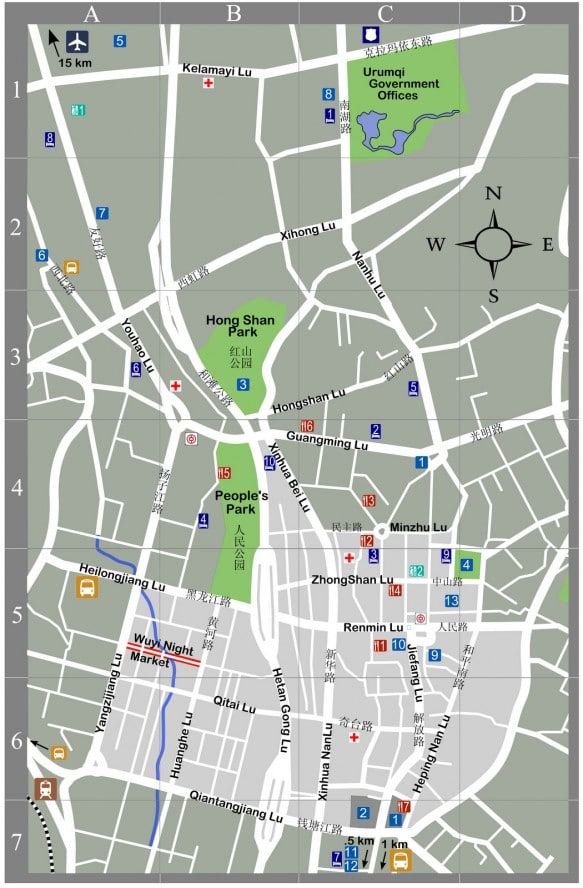
Kashgar City Guide | Turpan City Guide
Free Download “5 Things You Must Know Before Traveling to Xinjiang”!
Get Free Instant Access to this useful resource by entering your name and email below. You’ll also receive monthly travel updates, exclusive offers and travel tips.
©2024 Far West China | Resources | Contact | Privacy Policy

- [email protected]
- 86-773-286-5632 (Intl rates apply)
Urumqi Travel Guide
The city of Urumqi (alternately spelled Urumchi in older, Western texts, and transliterated "Ürümqi" in the language of the Uyghurs, meaning "beautiful pasture"), located in Xinjiang (Xinjiang Uyghur Autonomous Region), is situated in a break, or valley, in the west-east oriented Tian Shan Mountian Range, toward the eastern end of the mountain range. The valley, which forms a natural corridor running roughly northwest to southeast through the Tian Shan Mountains, came to be known by the English name of the city at its center, Urumchi. The Urumchi Corridor, as it is thus called, eventually came to be part of one of the many branch routes along the Silk Road – in this case, a northern route, since it skirted northward around the Tian Shan Mountains via the Urumchi Corridor at whose southern extremity lies the Xinjiang city of Turpan (often written "Turfan" in older texts).
Thus, this alternative – and somewhat less-trafficked – northern Silk Road route can be described as a cul-de-sac, or closed-loop, that branched off the main northern Silk Road route that rims the northern edge of the Taklamakan Desert, or the route that follows the southern contours of the Tian Shan Mountains, if you will. This secondary northern route – located north of the main northern route in this particular part of Central Asia, and which passed through the present-day city of Urumqi – originated in the city of Turpan and ended in the city of Samarkand, Uzbekistan (or vice-versa, depending on one's direction, of course).
Before the emergence of the city that would become the present-day city of Urumqi, the first known village near the site of present-day Urumqi was called Urabo, and was the seat of the then Luntai County (present-day Luntai County is much larger and has shifted farther south, nearer to Lake Lop). The ruins of Urabo Ancient City lie about 10 kilometers south of the southern perimeter of Urumqi (as Urumqi expands, it will surely engulf this ancient city). The area was frequented, if not settled, by Neolithic Age hunter-gatherers, though little is known about them, and it appears that they had developed very little in the way of a culture that could be transmitted. We are on much more certain anthropological-historical ground when discussing the area's pre-Han (BCE 206 – CE 220) Dynasty history and its turbulent Chinese history, as the next section indicates.
A Brief History
The first historically known inhabitants of the area were nomads, referred to as the Jushi People (alternatively known as the Gushi People), who were members of the same large flock – or perhaps wave after wave of flocks – of Caucasians who had migrated from Europe (Eastern Europe and southwestern Russia) to China across the Eurasian Steppe (think: Yuezhi cum Tocharians, such as the Tarim Mummies). Their largest city, Jiaohe ( Yarghul , in Uyghur), was built beginning in the 2 nd century BCE and survived until the 5 th century CE (note that this end period coincides with the extreme aridification of the area around Lake Lop, which, today, is a lake in name only, and which aridification also spelled the end of the Tocharians).
The Gushi was conquered by the Western Han (BCE 206 – CE 009) Dynasty in BCE 107, but continued to rule locally as a vassal state, though it was eventually divided into a Kingdom of Nearer Jushi and a Kingdom of Further Jushi in BCE 60 by the Han Dynasty rulers. The Han Chinese influence in the region was not, however, uninterrupted throughout the period, for the ancient arch-enemy of the Han, the Xiongnu, eventually moved into the area and took control of various parts of it, losing some of these and regaining some or all of them – and losing them yet again, in a protracted tug-of-war with the Han Chinese. From BCE 60 onward, the Han Chinese were finally on a better footing in the region.
The Kingdom of Gushi comprised an area that included the present-day Urumchi Corridor, but which was concentrated near the southern mouth of this corridor, in and around the present-day city of Turpan. Ancient Jiaohe lies some 15 kilometers west of Turpan.
The Gushi Culture made use of cannabis as a pharmacological/ psychoactive substance, presumably in connection with their shamanistic religious practices. A modest portion of cannabis (almost a kilo) was found at the feet of a Gushi shaman of Caucasian origin whose tomb was discovered among the Yanghai Tombs in the vicinity of the village of Shanshan near Turpan, a site that it credited to the Gushi Culture. The remains of the shaman is dated to circa 700 BCE, the same time frame as the Spring and Autumn (BCE 770-476) Period of the Eastern Zhou (BCE 770-221) Dynasty.
The cannabis might conceivably have been used for medicinal rather than religious purposes since shamans served as healers both in the physical as well as in the spiritual realm. In any case, the modest cache of "pot" that accompanied the earthly remains of the Gushi shaman was most likely either intended for the shaman's personal use on the journey toward the next life, or for his professional use in the next life, once he had arrived, so that the shaman could "hit the ground running", to put it in modern terms. The unusual find represents the oldest known use of hemp for purposes other than rope- and cloth-making.
After the demise of the Gushi Culture in the Urumqi Corridor area, including the southern mouth of the corridor, where it meets the northern rim of the Taklamakan Desert, nothing of consequence was heard of the area until Emperor Taizong of the Tang (CE 618-907) Dynasty, whose reign was from CE 627-649, built a new county seat here, Luntai Town (in Luntai County), near Urabo Ancient Town, the county's older seat.
Chinese emperors were becoming extremely tax-minded, and the Tang Dynasty was perhaps more focused on the "need" for taxes than most dynasties, given its extravagant court style (it should be noted that the Han Chinese empire – in precisely the form of the Tang Dynasty – pulled out of the "Western Regions" (including Xinjiang) for around a century (the vacuum was filled by the Tibetans), precisely due to the financial difficulties involved in funding its own military presence there, and rule by proxy via a vassal state was seen as an unattractive option at the time). Therefore the re-establishment of Luntai County, as it were, with Luntai Town as its new seat was part of the Tang Dynasty's effort to collect taxes on the lucrative Silk Road trade, wherever this trade led.
But even after the Tang Dynasty reestablished control over its former "Western Regions", with the aid, curiously, of the Uyghurs, little was heard of Luntai County. It was not until the Jürchens cum Manchus, yet another Turkic tribe, became the rulers of China in the form of the Qing (CE 1644-1911) Dynasty that the Chinese made their re-entry into Xinjiang in a demonstrative manner, suppressing the Dzungars and, as an unintended consequence, creating a bit of space for Uyghur influence to again spread across Xinjiang, as the second footnote below indicates.
When, in 1763, Xinjiang was definitively placed under direct Chinese rule, the city of Urumqi became the province's capital and the city's name was changed to Dihua ("to enlighten"). The reason for the large number of Russians in the city is owing to the fact that remnants of the White Russian Army fled to various parts of China, including Urumqi, during the Russian Revolution of 1917. Thereafter Dihua came to be divided into three ethno-sectarian suburbs: one housing the city's Muslims, one housing the Han and other, non-Muslim Chinese residents, and a third suburb that housed the city's Russian expats. It was first after the final victory in 1950 of the Chinese Communist Revolution, or the War of Liberation, as it is known in China, that the city of Dihua reverted to its older name, Urumqi, in 1954.
The Hutubi Petroglyphs (Rock Art)
Generally speaking, Chinese petroglyphs, or Neolithic rock art, can be separated into two main categories: engravings, found chiefly in northern China; and paintings, found chiefly in southern China. The evidence suggests that petroglyphs in ancient times were spread throughout China, representing the local cultures of a myriad of small Neolithic communities that inhabited most of China, each community separated – though not isolated – from the others by rivers, mountains and other natural, topographical features, that the spread of agricultural development, especially in the Central Plains area of China (aka the "Cradle of Chinese Civilization"), resulted in the obliteration of most of the ancient petroglyphs in these areas.
According to Professor Emmanuel Anati, founder of the Camunnian Center of Prehistoric Studies in Val Camonica (Camonica Valley) in the county of Capo di Ponte in the province of Brescia in the Lombardy region of northern Italy, petroglyphs the world over can be divided into 5 anthropological-developmental phases, or periods, corresponding to: 1) hunters, 2) pastoralists, 3) complex economy, 4) farmers and 5) voyagers.
Most of the petroglyphs in China appear on cliff faces or on the relatively flat, vertical surfaces of very large boulders, though some appear on the walls of caves. The petroglyphs of Hutubi, located about 75 kilometers southwest of the seat of Hutubi County (i.e., the city of Hutubi, itself situated about 50 kilometers northwest of Urumqi), are engravings and belong to the pastoralists' anthropological-developmental period.
The unique feature of the Hutubi Petroglyphs is that they represent what appears to be a fertility ritual, a social phenomenon that was widespread in early human development and is a very common theme in especially the rock art of India, where successful mating (i.e., leading to reproduction) of both man and animals was considered essential to the survival and multiplication of humankind. In India, it is not unusual to find petroglyphs depicting not only the genitalia of humans – as with the Hutubi Petroglyphs – but also the depiction of animals in the act of copulation.
Indian texts suggest that collective sexual rituals, or "orgies", as it were, were regularly held, and orchestrated by the shaman, where the males and females first let themselves be stimulated by observing the sexual pairing of a male and female animal – such as a pair of horses or a pair of cattle – that had been placed in the center of the group. In an age when infant mortality was probably higher than it has ever been since, reproduction – or regeneration, as it is more neutrally called in scientific circles – was essential to the survival of the group, therefore the existence of such fertility rituals.
The Hutubi Petroglyphs are stylized human forms – almost stick men and -women, in fact, but remarkably elegantly shaped for such stylized forms – the majority of which are males with an exaggeratedly long phallus. There are some 300 figures here, ranging in height from a mere 10 centimeters to 2 meters. Most of the women figures (understood to be women because their genitalia is not shown) appear to be dancing, which would fit the suggested image of a fertility ritual since the sexually evocative dance movements of the females would excite the males.
A few of the female figures appear to be lying on their backs, their legs spread, with males standing over them with their exaggeratedly long phalluses pointing down toward the respective females, though this is surely evidence of the inability of Neolithic Age artists to master the art of depth perception, i.e., the proper division of a scene into a foreground, middle ground and background so as to imitate the perspective of three dimensions. The one-at-a-time, pairwise mating might also suggest that the ritual did not cease all at once, with all the men and women forming pairs, but that a single male and a single female would pair off, perhaps while the rest of the women continued dancing (and the other males looking on), and perhaps this conjectured public voyeurism played the same role as that of the coupling of animals in the similar Indian fertility ritual. For that matter, perhaps a single female mated with numerous males during the mating ceremony, thus increasing the likelihood that she would be "fertilized".
The fact that such fertility rituals are not present in any other petroglyphs in China is itself an interesting anomaly since it suggests that there was something uniquely stark, as some have suggested, about the cycle of life in this part of the world – where frigid, ice-capped mountains were separated from baking hot basins by only a few kilometers – that fostered such an intense focus on procreation, or, that the people who etched the fertility ritual images on the rock face near Hutubi were migrants who had arrived from other areas in the region and who had brought their special fertility rituals with them.
Present-Day Urumqi
Urumqi boasts a distinction that sets it apart from all other cities in the region: it is the geographical midpoint, longitudinally (i.e., measured east-west) of the Eurasian continent. Put slightly differently, Urumqi is the city that lies farthest from both the Atlantic and Pacific Oceans (in fact, this distinction has earned the city a place in the Guinness Book of World Records). Its relative size and youthful age (compared to many other, ancient Chinese cities) notwithstanding, Urumqi, a city of some 2 million inhabitants – of which some 340,000 live on the rural fringes of the city – boasts a large ethnic mix, representing 46 ethnic minorities as well as the Han Chinese majority. Urumqi's minority groups are too numerous to name here, but among the most populous groups are the following (though listed here strictly in alphabetical order): Hui, Kazakh, Kyrgyz, Manchu, Mongolian, Russian, Tajik, Tatar, Uygur, Uzbek and Xibe.
The city of Urumqi lies between the ice-capped Bogda Peak of the Tian Shan Mountains and Chaiwobao Salt Lake. There are pine-covered rolling hills here, interspersed with vast grasslands, dotted with lakes. To the northeast lies the Dzungarian Basin. The summers and winters here are long, while the spring and autumn seasons are but short, transitional periods. The summers are hot, though not excessively hot, with a maximum temperature of 30 degrees Celsius, while the lowest winter temperature is roughly minus 7½ degrees Celsius.
Some of the unique ethnic traditions of Urumqi include muqimi, the mother of Uyghur music; Jiang-ger, the heroic poems of the Mongolian cultural identity; and manas , the epic songs of the Kyrgyz cultural identity. Urumqi still has its neighborhoods, or quarters, where different ethnic groups dominate; on the main thoroughfares, one typically sees people dressed in modern, Chinese-and-Western attire, while on the smaller back streets, one often encounters people dressed in more traditional, ethnic attire, especially women clothed in colorful dresses and often wearing hats or other headdresses. On festive occasions, typical steppe cultural activities include wrestling, horse racing, sheep herding and girl's whip (a pair of riders, a girl and a boy, each on his/ her separate mount, with the girl outfitted with a whip that she uses on the boy – if she can catch him, that is – thus inspiring the boy to avoid such whipping, and leading to either a highly spirited or a somewhat comical race... the girls do not whip the boys cruelly, of course).
There are many specialty shops and a few bazaars in Urumqi where one can find unique bargains such as carpets, folk music instruments, colorful hats and other traditional ethnic attire as well as smaller souvenirs and ethnic bric-a-brac. Two of the most popular such bazaars are the Erdaoqiao Bazaar and the International Grand Bazaar. Other must-see sights in and around Urumqi include: Hongshan ("Red Hill") Park; Lake Tianchi, aka Heavenly Lake; Nanshan ("Southern Mountain") Grassland, aka Southern Pasture, which is a large grassland comprising several tourist attractions such as the Baiyanggou Resort Area; Caiwobao Salt Lake; the Xinjiang Silk Road Museum; and of course, the Xinjiang Regional Museum , or the Museum of Xinjiang Uyghur Autonomous Region, which also houses the many archeological finds of Xinjiang, including the famous Tarim Mummies of mysterious Caucasian origin.
You might also like to visit Shaanxi Great Mosque or one of Urumqi's other mosques, Hezhou Mosque, Qinghai Mosque, Southern Mosque or Tartar Mosque. If you are impressed with the Tocharian Tarim Mummies, you might also want to pay a visit to the even more ancient Hutubi Petroglyphs located about 100 kilometers west-southwest of Urumqi, where the Urumchi Corridor meets the Tian Shan Mountains.
The city of Urumqi can offer a wide range of accommodations and dining experiences, the latter to include local ethnic food, traditional Chinese food and of course Western food, including the many international fast-food chains. The bazaars also have early-evening entertainment, and of course, many ethnic eateries. Urumqi also has many bars and cafés where you can relax over your favorite beverage and strike up a conversation. The accommodations range from simple bed and breakfast arrangements to first-class, star-rated hotels such as the Sheraton Urumqi Hotel. Thanks to Urumqi's mild, summer evening weather and to its broad cultural diversity, it is an interesting place to chill out on a summer's eve and simply enjoy the experience of being in a foreign place on an unhurried, foreign clock.
Additional Instructions
Samarkand itself lay on another northern branch, or loop, of the Silk Road that originated in the city of Kashgar, Xinjiang, and ended in the city of Merv in present-day Turkmenistan. The corresponding southern branch to this loop, whose terminal points are identical to those of the northern branch, i.e., the cities of Kashgar and Merv, passed through the Wakhan Corridor westward across the northern part of Afghanistan (the Wakhan Corridor lies in Afghanistan of course, stretching from the Taklamakan Desert in the east to the city of Eshkashem in the west), whose most famous Silk Road cities were Kunduz and Balkh – that is, before Genghis Khan overran and sacked the latter city, which was one of the wealthiest, most prosperous cities along the ancient Silk Road (which was probably why Genghis Khan had the city in his sights in the first place).
Later, the much smaller city of Mazar-e-sharif, lying just east of Balkh, took over the powers, including the role of prominent Silk Road city, of the city of Balkh, which ancient city never recovered from the ravages wrought upon it by Genghis Khan and his Mongol Horde. Note also that the Xinjiang city of Kashgar, the point of origin of the westward loop described above, was also the terminal point of a similar loop that skirted around the northern and southern edges of the Taklamakan Desert, or either followed the contours of the Tian Shan Mountains (the northern route) or the contours of the Kunlun Mountains (the southern route).
It should also be noted that before a Silk Road route via the Urumchi Corridor came into being, there was surely an "upland" market for the exchange of goods arriving in Turpan. That is, the ancient city of Urabo, the precursor to modern-day Urumqi, most likely delivered goods to the Silk Road market in Turpan, just as some of the exotic wares from both the east (China proper) and the west (Central Asia and farther west) that arrived in Turpan found their way to Urabo.
In other words, the idea of cutting a caravan path through the Urumchi Corridor was probably linked to the fact that there was already a market for goods in the Urumchi Corridor, and perhaps the Gushi rulers of the area provided safe passage for caravans through the corridor and on to a safe point westward, beyond the southwestern rim of the Dzungarian Basin (aka Jungar Basin), perhaps in agreement with the Göktürks of the Western Turkic Khaganate who inhabited the Dzungarian Basin from the 6 th century CE onward, until the area fell to the Mongolians (the Dzun-gar of Dzungaria means, in Mongolian, "Left Hand", otherwise referred to as the "Left Wing", as in "the Army of the Left Wing", or "the Army of the Left Flank"), if indeed, this latter precaution was at all necessary, since it is reasonable to assume that the Göktürks themselves were interested in facilitating such trade.
In CE 840, the Uyghurs were driven out of their homelands further north and east of their present-day "homelands" by another Turkic nomadic group, the Kyrgyz – the Uyghur Khaganate, at its pinnacle, stretched from the Altay Mountains in the west to Manchuria in the east – fleeing thereafter southwestward to the area around Turpan, a city with which the Uyghurs had long maintained close relations due to Silk Road trade interests. Once established in Turpan, the Uyghurs discovered that their overall political and economic interests coincided with those of the rulers of the Tang Dynasty, and thus the Uyghurs helped the Tang emperor to drive out the Tibetans.
This is neither the time nor place to develop this thoughtfully, but it is a curious thing that the Kyrgyz have a different "take" on the CE 840 exit of the Uyghurs from the Uyghur Khaganate... the Kyrgyz, who lived among the Uyghurs as, shall we say, second-class citizens, felt enslaved within the Uyghur Khaganate and eventually rebelled, but instead of a Kyrgyz exodus from the region á la Moses' exodus from Egyptian slavery, the Kyrgyz rebels managed to drive out the Uyghurs. The Kyrgyz manas, the epic songs of the Kyrgyz cultural identity, is precisely an account of the Kyrgyz struggle to break the yoke of their enslavement to the Uyghurs and, in all fairness, also to the Han Chinese.
The Uyghurs then served as a minor vassal state to the Chinese emperors for several centuries, sharing the Tarim Basin with numerous other city-states, though this is not to say that Xinjiang in general, and the Tarim Basin in particular, was populated wholly, and throughout the period from the close of the Tang Dynasty onward, by vassal states that were loyal to Han China, quite the contrary, as the 18th-century conflict with the Dzungars would demonstrate (see below). In the Tarim Basin, the Uyghur influence spread, with the Uyghurs eventually establishing the Kingdom of Kashgar; the Id Kah Mosque, located near the city of Kashgar, was built during this period of rule in CE 1442, and remains to this day the largest mosque in all of China (Islam was introduced into China already in the beginning of the 7 th century, though it first began to take hold, and principally in western China, after the Mongol emperors of the Yuan (CE 1279-1368) Dynasty showed favor to Muslim scholars and administrators – Buddhism was the dominant religion in China during the period, as it still is... indeed, the Yuan rulers were themselves devout Lamaists, or Tibetan Buddhists).
One of the other, larger vassal states in the Tarim Basin was ruled by the Khitans, another Turkic group that had been driven out of their homelands farther north by the Jürchens, settling, like so many other refugee Turkic tribes, in the Tarim Basin or elsewhere in Xinjiang. Both the Khitans and the Jürchens would later be driven out of their respective land holdings in the area of Xinjiang-Greater Mongolia by the Mongols. After the Mongol-led Yuan Dynasty came the Han Chinese Ming (CE 1368-1644) Dynasty, which was followed by China's last Imperial dynasty, the Qing Dynasty, led by the Jürchens cum Manchus, one of the many Turkic tribes that had pushed south into China from southern Siberia and Manchuria over the centuries.
Much had changed in Xinjiang by the time of the Qing Dynasty. For one thing, the Mongolian Dzungars ruled the area of Xinjiang, not as a loyal vassal to the Chinese emperor, but as a more or less independent state, or khanate, that stretched from the western extremity of the Great Wall (the Lake Lop area) westward to the western boundary of present-day Kyrgyzstan, and from the southern boundary of present-day Kyrgyzstan northward to present-day southern Siberia, which swath of land comprised most of present-day Xinjiang. The V Dalai Lama, Ngawang Lobsang Gyatso, bestowed the title of Boshogtu Khan on the Dzungar ruler, Choros Erdeniin Galdan, in 1678, and Galdan was succeded by Tsewang Rabtan in the same title. It was only after the death of the latter that the Dzungar Khanate began to weaken, and this was the moment that the Chinese emperor chose to make a stand against the khanate.
Though Rabtan died in 1727, the khanate hobbled on for another 30 years before an ambitious Emperor Qianlong, in 1756, launched a short but bloody military campaign to suppress the Dzungars (the campaign was completed in 1759). The Dzungars, as indicated above, were a branch of the Mongolian family of tribes. The Qing conquest of the Dzungar Khanate was singularly bloody, amounting to what one today would inarguably call ethnic genocide; for all their ferocity against outside foes, the Turkic tribes seem to have reserved their greatest enmity for fellow Turks!
Urumqi Weather
Urumqi lies in the west direction of China, having distinctive seasons. It is hot and dry in summer with average temperatures in July at 26 ºC (78 ºF) and damp and cold in winter with average temperatures in January of -15 ºC(5 ºF). It's a good idea to pack for extremes if you plan to travel much outside of Urumqi, as temperatures can vary greatly with the change of elevation and time of day, even in summer.
Request a custom itinerary today and get one step closer to your personalized trip
Create Your Trip
Urumqi: The Colorful Modern Capital Of The Silk Road
Urumqi is a fascinating city located in the Xinjiang Uygur Autonomous Region of China, known for its unique blend of cultures, vibrant history, and delicious cuisine. In this article, we will delve into Urumqi with the purpose of learning Chinese , covering topics such as tourism , the pronunciation teaching of "乌鲁木齐"( wū lǔ mù qí ) Urumqi in Chinese, historical highlights, local specialty cuisine, and customs.
旅游 (Lǚyóu) - Tourism
Urumqi boasts a diverse range of tourist attractions that showcase the region's natural beauty and cultural diversity . One of the must-visit places is the 天池 ( Tiān chí ) Heavenly Lake, a stunning alpine lake nestled amidst the Tianshan Mountains. 大巴扎 ( Dà bā zhā ) The Grand Bazaar is another highlight, where visitors can immerse themselves in the bustling market atmosphere, shop for local handicrafts, and sample delicious Uygur cuisine.
历史 (Lìshǐ) - History
Urumqi has a rich historical background and has been a vital trading hub along the ancient Silk Road. This region has been influenced by various cultures over the centuries, resulting in a unique blend of traditions. 新疆维吾尔自治区博物馆 ( Xīnjiāng Wéiwú'ěr Zìzhìqū Bówùguǎn ) The Xinjiang Regional Museum offers visitors insights into the region's historical and cultural development.
当地特色美食 (Dāngdì Tèsè Měishí) - Local Specialty Cuisine
Urumqi is famous for its delectable Uygur cuisine, which features a delightful mix of Middle Eastern and Central Asian flavors. 羊肉串 ( Yángròu chuàn ) Lamb skewers , 拉面 ( Lā miàn ) hand-pulled noodles , and 抓饭 ( Zhuā fàn ) pilaf are some of the must-try dishes. Urumqi's street food scene is vibrant, with various stalls offering an array of tasty snacks and desserts.
习俗 (Xísú) - Customs
The people of Urumqi follow a rich tapestry of customs that reflect the cultural diversity of the region. Uygur music and dance performances, such as the traditional 多兰木卡姆 ( Duōlán Mùkǎmǔ ) "Dolan Muqam", showcase the region's artistic heritage. 那达慕 ( Nà dá mù ) The Naadam Festival is a significant event that features various traditional sports and competitions, bringing people together in celebration.
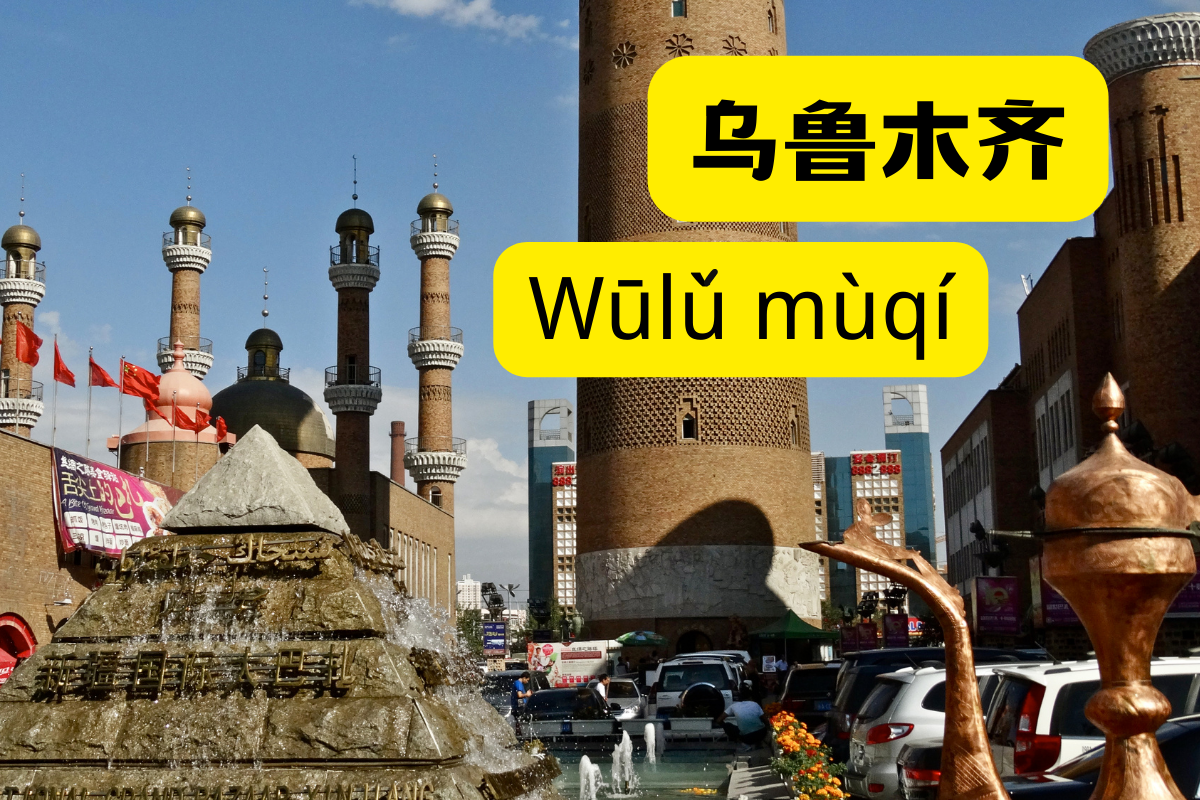
There are four tones in Chinese. The four characters "乌鲁木齐 wū lǔ mù qí " happen to encompass the four tonal variations found within Mandarin Chinese phonetics.
乌 ( Wū ) - The first character is "乌," pronounced as "Wū" with the first tone. For the first tone, It is high pitch and flat. Similar to the way we say "maybe" in English when expressing uncertainty. It corresponds to the first syllable "may" in the word “maybe."
鲁 ( Lǔ ) - The second character is "鲁," pronounced as "Lǔ" with the third tone. For the third tone, it goes down first, then goes up. Similar to the way we say "well" in English when you are thinking.
木 ( Mù ) - The third character is "木," pronounced as "Mù" with the fourth tone. For the forth tone, it goes down quickly, we can also say it is angry voice. Similar to the way we say "Ouch" in English when you are angry.
齐 ( Qí ) - The fourth character is "齐," pronounced as "Qí" with the second tone. For the second tone, it goes up. Similar to the way we say "what" in English when you are surprised.
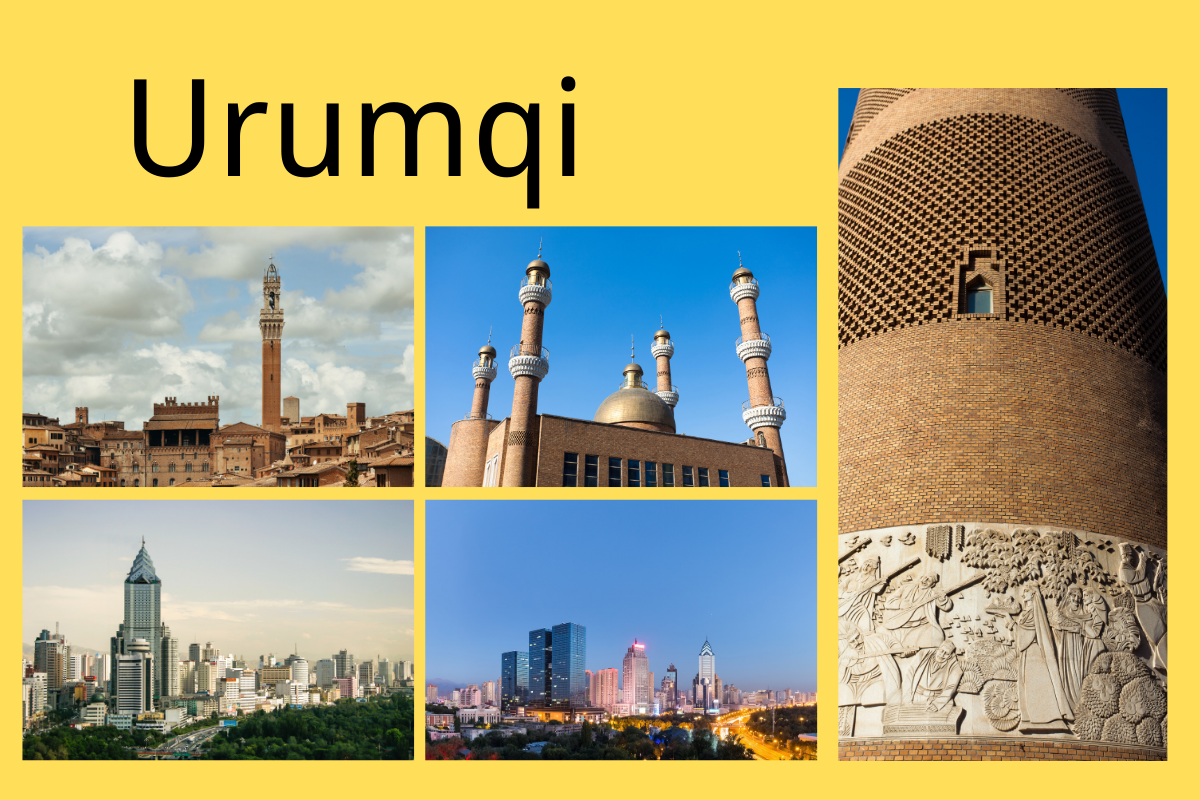
Urumqi is a vibrant city that captivates visitors with its cultural richness and warm hospitality. 乌鲁木齐是一座充满活力的城市,以其文化的丰富和热情好客吸引着游客。 Wūlǔmùqí shì yī zuò chōngmǎn huódòng de chéngshì, yǐ qí wénhuà de fēngfù hé rèqíng hàokè xīyǐn zhe yóukè.
I had the pleasure of trying the delicious Uygur cuisine in Urumqi, and it was an unforgettable culinary experience. 我在乌鲁木齐有幸品尝了美味的维吾尔菜肴,这是一次难忘的美食体验。 Wǒ zài Wūlǔmùqí yǒuxìng pǐncháng le měiwèi de Wéiwú'ěr càiyáo, zhè shì yī cì nánwàng de měishí tǐyàn.
Urumqi's Naadam Festival is a joyful celebration filled with traditional sports and cultural performances. 乌鲁木齐的那达慕节是一个充满传统体育和文化表演的喜庆庆典。 Wūlǔmùqí de Nàdámù Jié shì yīgè chōngmǎn chuántǒng tǐyù hé wénhuà biǎoyǎn de xǐqìng qìngdiǎn.
Sign up for a free trial now!
30-day money back guarantee.
If you are not satisfied with the lesson, you can get a refund at any time within the first month.
Pay by Installments
We accept payment via Paypal. According to the package you purchased, you can enjoy installment payment.
Long validity period
In addition to the suspension provided by the course, you can also apply for 2 suspensions for free
How to visit Summer Palace (Tips, Photos & Map)
A comprehensive guide to visiting the temple of heaven.
- Plugs, Sockets, Adapters and Electricity in China
10 Fascinating Facts about China
China Travel Tips
Tour-Beijing.com – your one-stop place for planning your trip to Beijing China
Beijing Travel Tips
Visiting the Great Wall is a delightful must for the first-time visitors to Beijing China.

Beijing in March Travel Guide (Weather, Wear, Events & Tips)

How to Visit Mutianyu Great Wall (Tips,Photos & Map)

How to visit Jingshan Park

How to Visit Forbidden City (Tips, Photos & Map)
- China Travel
- China Top 10
Top 10 Attractions in Urumqi, Top Things to Do in Urumqi
- Urumqi Travel
Plan your Urumqi tour ? Urumqi, capital of Xinjiang Uyghur Autonomous Region, is very often your springboard to delve into the expansive province. Urumqi itself is worth a pop by on your Xinjiang trip. It is the largest city in Western China. Urumqi is quite famous for its claim that it is the most inland major city in the world, that being the furthest from any ocean.
Urumqi, with its unique geographic location and its long, rich history, has forged a vibrantly unique culture in this ancient western region. It is an important post on the famed, ancient Silk Road. A great variety of peoples, costumes, languages, religions and customs have forged the unique features of Urumqi.
No. 01: Heavenly Lake The Heavenly Lake, or Tianchi Lake, is located at the mountainside of the Bogda Peak, the highest peak in the east range of Tianshan Mountain, about 110 kilometers to Urumqi of the Xinjiang Uygur Autonomous Region.
In ancient times, mud-rocks that flowed down from the glaciers and blocked the river course formed the Tianchi Lake. About 1,980 meters above sea level, the lake has a shape of half-moon and covers an area of 4.9 square kilometers. In summer, the Tianchi Lake is a perfect resort in the sweltering desert. One can enjoy the pure and fresh air as well as the cool and pleasant weather.
Entrance Fee: CNY 100 (peak seasons); CNY 40 (low seasons) Opening Hours: 08:00-19:00 How to get there: there are shuttle buses at Renmin Park and Hongshan Hotel, you can take the shuttle to the Heavenly Lake
No. 02: Xinjiang Uighur Autonomous Region Museum 新疆维吾尔自治区博物馆 The Xinjiang Uighur Autonomous Region Museum was established in the spring of 1953 in the People’s Park in Urumai City. The museum boasts a collection of 32,000 cultural relics, 288 of which are of the national first class.
The articles on display at the museum highlight archaeological finds from the Silk Road and local cultural relics. The Museum features two basic displays: the Display of Xinjiang Historical Relics and the Display of Xinjiang Folklore.
Entrance Fee: free Opening Hours: 09:30-19:00 How to get there: take Bus No. 7 from Hongshan Market
No. 03: Glacier No.1 Glacier No. 1 is the headstream of Urumqi River which is located about 120 kilometers southwest of Urumqi city, on the north face of Tian Ge Er Peak.
Of the 5 glaciers around Urumqi, Glacier No.1 is the largest and it also claims fame as the closest glacier to a metropolis in the world. Its height ranges from 3800 meters to 4000 meters with a length of about 2.4 kilometers.
Its average width is 500 meters with maximum thickness of about 140 meters, and it encompasses an area nearly 2 sq/km. Glacier No.1 is honored by geologists as the “living fossil”.
Entrance Fee: CNY 15 Opening Hours: 09:30-17:30 How to get there: You’d better take an off-road vehicle and guide by some skilled persons to go to the Glacier No. 1.
No. 04: Red Hill Park Red Hill gets its name from its reddish brown color. The hill spans 1.5 kilometers long from east to west at an altitude of 910 meters and a relative height of 400 meters.
Red Hill Park is basically in the center of the city of Urumqi and is easy to find since the hill is noticeable with a nine-story red brick pagoda called Zhen Long Ta on top. It is uncertain when the pagoda was built. The park is a fun place to go. There are some trees and gardens, and you can cross the road to nearby People’s Park .
Entrance Fee: CNY 10 Opening Hours: 10:00-19:00 How to get there: take Buses No. 1, 7, 50, 61, 62, 68 or 101 to the Red Hill Park
No. 05: Shaanxi Mosque The Shaanxi Mosque is a rare Hui Chinese mosque in the predominantly Uygur city of Urumqi which was built during Qing Dynasty rule under the reign of Emperor Qianlong or Emperor Jiaqing.
The mosque is built in the Han Chinese architectural tradition of pavilions with upswept eaves made of timber beams, columns and brick and also manifests Islamic influences from the west in its use of glazed tiles.
It consists of an elevated prayer hall within a high-walled precinct, marked by the bangke tower crowning its mihrab chamber.
Entrance Fee: CNY 10 Opening Hours: 08:00-16:00 How to get there: You’d better take an off-road vehicle and guide by some skilled persons to go to the Shaanxi Mosque.
No. 06: Grand Bazaar Grand Bazaar, also known as International Grand Bazaar, is an Islamic bazaar in Urumqi Xinjiang. It is the largest bazaar in the world by scale, combining Islamic culture, architecture, ethnic commerce, tourism and entertainment.
In the international bazaar, there are all kinds of shops, as well as food plaza, theatre and churches. Two areas are particularly interesting and shouldn’t be missed when visiting the Bazaar.
The NO.1 building and the NO.3 building offer global and domestic delights for every taste. There are also wonderful performances every evening in the bazaar.
Entrance Fee: free Opening Hours: the whole day How to get there: there are several buses in the downtown area can reach Grand Bazaar
No. 07: Kanas Nature Reserve Located in Burqin County of Altay City within the Xinjiang, Kanas Nature Reserve boasts a beautiful natural ecosystem formed by lakes, rivers, glaciers, forests, and grasslands.
This nature reserve, which incorporates forests, grasslands, glaciers, permafrost, mountains, rivers, lakes and other extreme northern ecosystem landscape elements, has diverse rare animals and plants and is rich in other wildlife resources. The highlight of Kanas Nature Reserve would probably be Kanas Lake.
It is an ideal area for scientific research, observation adventure, eco-tourism, film and television production, painting and photography.
Entrance Fee: free Opening Hours: 08:00-18:00 How to get there: take Buses No. 30, 104, 60 or 537 to get the Kanas Nature Reserve
No. 08: Mount Nan Pastures Located on Kelawucheng Mountain, a branch of north Heavenly Mountain to the south of Urumqi , Xinjiang, Mount Nan Pasture is a great place for horse riding and relaxing in beautiful natural scenery.
The pasture is a fertile place with charming mountains around. It is cool here in the summer, and is a good place to get away from the heat. This is a natural pasture.Besides the animal husbandry, the pasture also has great many tourist attractions.
Entrance Fee: CNY 20 Opening Hours: the whole day How to get there: There are Tourist Buses outside Renmin Park
No. 09: Wulabo Ancient Town Wulabo Ancient Town ( also konwn as Ulanbay ) is located 17 kilometers away from the southern suburb of Urumqi City near Wulabo Reservoir, it is also called Pochengzi. It is an ancient site from the Tang to Yuan dynasties, with walls that are well-preserved and measure 4 meters high 480 meters long from east to west and 550 meters long from north to south.
The town is divided by a wall into northern and southern parts. Many ancient tombs and relics were uncovered in the south of Wulabo Reservoir in 1983. Apart from stone tombs, most of the relics were pottery works, gold earrings, copper mirrors, stone mortars and small ironware.
Entrance Fee: CNY 20 Opening Hours: 08:00-17:00 How to get there: take bus No.312 from North Railway Station of Urumqi, No.528 from Riyuexingguang Park,9 from Santunbei to Shuixigou Toll Station and exchange 312, 528
No. 10: Bayanbulak Grassland Covering an area of more than 23,000 square kilometers, Bayanbulak is the second largest grassland in China and is one the most important stock raising bases of Xinjiang.
Bayanbulak means “abundant spring water” in Mongolian. If you come here you will be provided a unique chance to enjoy vast green grasslands which stretch as far as the eye can see. In this vast Bayanbulak Grassland there is the famous Swan Lake. Specifically, Swan Lake is a wide area of wetland that is made up of many interconnected small lakes.
Entrance Fee: CNY 15 Opening Hours: 09:30-17:30 How to get there: take the Tourist Bus to Bayanbulak Grassland from Nianzigou Bus Station of Urumqi
Urumqi Highlight Day Tour from US$119 p/p Urumqi Pasture Excursion Day Tour from US$89 p/p Urumqi 4 Day Tour from US$419 p/p Urumqi Turpan 4-Day Tour from US$325 p/p
Further Readings
Top 10 Attractions in Urumqi Best Urumqi Photos How to get from Beijing to Urumqi
8 thoughts on “ Top 10 Attractions in Urumqi, Top Things to Do in Urumqi ”
I was recently in Urumqi with a silk road tour. I noticed many beautiful ceramic murals on buildings. What can you tell me bout them and ceramic production in Urumqi. Thank you.
Hi S. P. Stein,
As far as I know these are local popular wall painting or wall murals. They are painted by hand on the walls, not necessarily made from ceramics. We don’t know much about the wall paintings. Check out the link ( A Page in Chinese ) to have a feeling of the wall painting business in Urumqi:
http://www.xjshqh.com/
I Will be in Urumqi on monday oktober 2. Will the Regional Museum be open then? How about the other musea?
Dear Dingena Donner,
As far as I know, all the museums will be open in Urumqi during Ocotber execept Monday. Monday is closed.
Dear friends, We are two girls from Vietnam and we plan to go to visit Xinjiang (Urumqi) area from 21 October and we are interesting for a 4-5 days tour. Could you please tell us if there is any available tour from that day and if there is any group tour we can join in. We have small budget and so we are fine to stay at any guesthouse during our stay there. We will have a flight to Chengdu on 18 October and we think to take train to go to Xinjiang (Urumqi), is it possible to make Chengdu-Urumqi in 2-3 days by train? We are looking forward to hearing from you soon. Kind regards, Lan Anh
Dear Lan Anh,
Thanks for your inquiry! But unfortunately we don’t have group tours available for you to join in.
There are two daily trains from Chengdu to Urumqi which takes 47 hours. Please use the following website to book your train tickets:
https://english.ctrip.com/trains/
Have a nice time in China!
@ Daniel. Are you a tour guide?
Hi Luc Swart,
Sorry for my delayed reply!
I used to be a tour guide 20 years ago. Any travel related questions, please email us at [email protected] . Thanks!
Leave a Reply
Your email address will not be published. Required fields are marked *
This site uses Akismet to reduce spam. Learn how your comment data is processed .
Related News
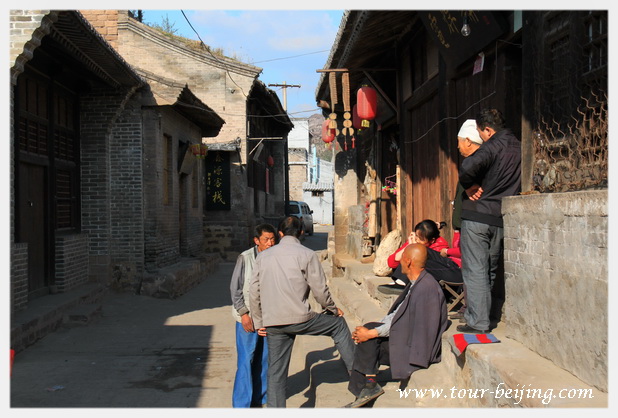
Top 10 Most Beautiful Mountains in China
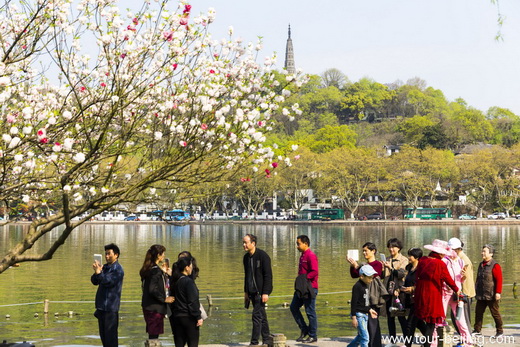
Top 10 Most Beautiful Lakes in China
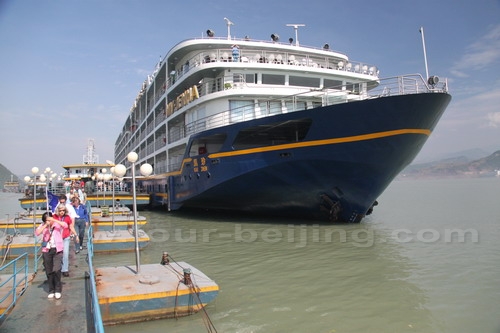
Top 10 Most Beautiful Rivers in China

IMAGES
VIDEO
COMMENTS
Urumqi, capital of Xinjiang Uyghur Autonomous Region, is the largest city in Western China. It also holds the record for the remotest major city in the world, and most "landlocked" as it's 2,500 km (1,400 mi) from the nearest sea. With a population of 3.5 million, it's surrounded my mountains and desert with no city its size in 1,800 km (1,100 ...
Urumqi Travel Guide 2024. Urumqi (乌鲁木齐) is the capital of Xinjiang which was called Dihu (迪化) and nowadays is often abbreviated to Wu City (乌市). The word - Urumqi means "beautiful pasture" in Mongol. Located in the central Xinjiang, the north foot of middle section of Tianshan Mountains and south edge of the Junggar Basin, the ...
As such Urumqi Airport plays a significant role for traveling to cities in China, East Asia, European countries and other destinations within Xinjiang. Long-distance buses to most attractions are available from the city. The Lanzhou-Urumqi high-speed train makes train trip to Xinjiang fast, convenient and comfortable.
If you travel from Urumqi to Turpan or... 9. Southern Mosque. 21. Religious Sites. By andrewmU2655XD. The main colour used on the mosque is green, and there are beautiful examples of wood carvings and columns used... 10. People's Park of Urumqi.
Urumqi is known for diverse natural landscapes and folk culture. On the one hand, tourists may fully enjoy the forest, pasture and snow-clad mountains, and activities such as horse riding and skiing. On the other hand, hospitable Uygur , Kazak people, as well as other ethnic groups, will entertain every tourist with their traditional food ...
Top Urumqi Attractions. Xinjiang International Grand Bazaar. The Xinjiang International Grand Bazaar is a popular tourist destination in Urumqi, Xinjiang, China. It is a vibrant and bustling market that showcases the rich culture and traditions of the region. The bazaar features a wide variety of stalls selling local handicrafts, textiles ...
Top 5 Urumqi Attractions | Thing to Do in Urumqi 2024. Urumqi, the capital city located in the northern Xinjiang, is more known as the gateway to Xinjiang and a vital transportation hub to get around Xinjiang. In fact, with rich tourism resources, Urumqi itself serves as an important travel destination too. The city owns more than stunning ...
Top Attractions & Things to Do in Urumqi More than a gateway to Xinjiang, Urumqi's diverse attractions and unique experiences make it a charming destination for any Xinjiang tour. Whether you are seeking cultural diversity or otherworldly natural marvels, look no further than Urumqi.
Urumqi, the capital of the Xinjiang Uygur Autonomous Region in China, is a city that offers a unique blend of history, culture, and natural beauty. With its diverse population and fascinating history, Urumqi is a destination that is often overlooked by travelers visiting China, but is well worth a visit. In this guide, we'll take.
The tourist treasures of Urumqi outshine those of many other provinces and cities. As an important strategic locale in the ancient Silk Road and the gathering place of historic East-West exchanges, it is home to numerous cultural relics and historic treasures. Thirteen main ethnic minorities offer souvenirs of their enduring colorful customs.
Urumqi (Pronounced: ÜH-RÜM-chee) (Chinese: 乌鲁木齐 Wūlǔmùq ... It is a popular tourist destination although somewhat of a tourist trap these days. However, the surrounding area is the heart of the Uyghur community and makes visiting worthwhile.
All Inclusive Private Day Trip to Turpan from Urumqi. 6. from $269 per adult. Private 4-Day Tour to Kuqa and Kashgar from Urumqi. 1. from $1,537 per adult. 2-Day Private Tour to Turpan from Urumqi: Karez System, JIaohe Ruins and More. 0 reviews. from $480 per adult.
All Inclusive Private Day Trip to Turpan from Urumqi. 5. from ₹23,106 per adult. Private 4-Day Tour to Kuqa and Kashgar from Urumqi. 1. from ₹1,32,057 per adult. 2-Day Private Tour to Turpan from Urumqi: Karez System, JIaohe Ruins and More. 0 reviews. from ₹41,229 per adult.
The best part of the Urumqi to Turpan drive is the pass through Dabancheng. You can stop at this tourist attraction for a snack and a sense of place (whilst whistling the tune of "The girl from Dabancheng" through your teeth.) If you don't know about this song, go to the Wang Lou Bin Museum in Grape Valley, Turpan (right, Alex?).
Urumqi Travel Tips help travellers to get to know Urumqi's climate and weather, local festivals and folk customs, banks, post offices, universities and useful phone numbers, etc. ... (Sichou Zhilu Bingxue Fengqing Jie) is a rising tourist festival in Urumqi. The grand opening ceremony is held in December and the festival usually lasts till the ...
Things to Do in Urumqi, China: See Tripadvisor's 7,532 traveller reviews and photos of Urumqi tourist attractions. Find what to do today, this weekend, or in July. We have reviews of the best places to see in Urumqi. Visit top-rated & must-see attractions.
Best of all, Urumqi is home to the Xinjiang Autonomous Region Museum, a must-see prior to any other travel throughout the province. Urumqi Hotels at a Glance: - Urumqi Sheraton: a 5-star option. - Luxemon Yindu: a 5-star option. - Lucky Chance: a comfortable 3-star. Urumqi Hostels at a Glance: - MaiTian Hostel: my recommendation.
Geographic Center of Asia. Although heavily disputed as being the true center of Asia, this geographical marker lies 20km south-west of the city of Ürümqi. The landmark is very much off the beaten track, as you must drive down some very neglected country lanes to get there. The area of the attraction seems very tired, but being able to stand ...
The city of Urumqi lies between the ice-capped Bogda Peak of the Tian Shan Mountains and Chaiwobao Salt Lake. There are pine-covered rolling hills here, interspersed with vast grasslands, dotted with lakes. To the northeast lies the Dzungarian Basin. The summers and winters here are long, while the spring and autumn seasons are but short ...
Urumqi is a fascinating city located in the Xinjiang Uygur Autonomous Region of China, known for its unique blend of cultures, vibrant history, and delicious cuisine. In this article, we will delve into Urumqi with the purpose of learning Chinese, covering topics such as tourism, the pronunciation teaching of "乌鲁木齐"( wū lǔ mù qí ) Urumqi in Chinese, historical highlights, local ...
Private 2-Day Trip to Turpan from Urumqi including Jiaohe and Gaochang Ruins. 0 reviews. from AU$1,041 per adult. 5-Night Silk Road Tour from Urumqi to Dunhuang. 0 reviews. from AU$3,427 per adult. 2-Day Private Tour to Turpan from Urumqi: Karez System, JIaohe Ruins and More. 0 reviews. from AU$787 per adult.
No. 03: Glacier No.1. Glacier No. 1 is the headstream of Urumqi River which is located about 120 kilometers southwest of Urumqi city, on the north face of Tian Ge Er Peak. Of the 5 glaciers around Urumqi, Glacier No.1 is the largest and it also claims fame as the closest glacier to a metropolis in the world.